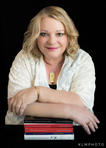Christy K. Robinson's Blog: William & Mary Barrett Dyer--17th century England & New England, page 24
September 2, 2011
The case of the surfing witch
© Christy K. Robinson
This story illustrates the common attitude toward 17th-century women whowere unusual or stood out from the crowd. Mary Dyer was never publicly or officially accusedof being a witch, but because of the times, and because of their beliefs andindependent actions, there were widespread rumors that she and Anne Hutchinsonwere witches. This was a danger every woman faced in the 17th century if shedidn't have the strength and protection of her husband's wealth and status.
In 1643, William Hutchinson had recently died and Anne Hutchinson and her younger children had moved away from Rhode Island to Dutch territory (near the Bronx) where they expected to be safe from the Massachusetts Puritans who were hounding her to recant, and attempting to annex Rhode Island to regain control over the very people they'd expelled for heresy in 1638! William Dyer, John Clarke, Roger Williams, and others were working diligently (and successfully) to obtain the first patent for Rhode Island from England. It defined their boundaries to prevent annexation and it allowed separation of civil and religious powers.
The first paragraph of the pamphlet's text speaks of the outrage of women aspiring to education and learning. Both Mary Dyer and Anne Hutchinson were learned women with keen minds and quick wits.
Now that the American scene is set, please think about their families, friends, and colleagues back in England--people they'd left only three to eight years before. The followingis a pamphlet that was published in 1643 England, during witch hunts byMatthew Hopkins. The story tells how during the English Civil War, soldiers found awoman surfing (like kids go boogie-boarding at the beach) on the River Newburyand killed her.
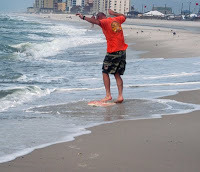
No doubt the soldiers were ogling the surfing woman in herwet, clingy dress. These were the Puritan (Parliamentarian) forces of OliverCromwell, the Ironsides regiment, and the woman's sarcastic wish for the Puritan Earl of Essex to"win the field" against the royalists was the last straw. Looking backfrom the 21st century, she probably wasn't even considered a witchuntil after she was killed--this story was a cover-up invention to justifythe soldiers' mob mentality and murderous actions.
AMOST Certain, Strange, and true Discovery of a WITCH
Being taken by some of the Parliamentary Forces, as she was sliding On a small planck board and sayling on it over the River at Newbery, Together with the strange and true manner of her death, with the propheticallWords and Speeches she used at the same time.
Printed by John Hammond 1643.
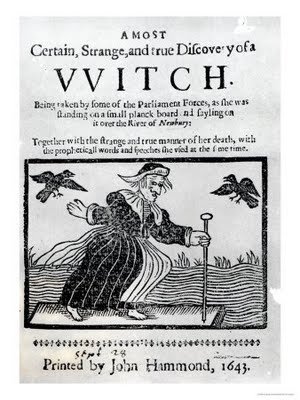
"Many are in the belief that this silly sex of Woman can by nomeanes attaine to that so vile and dammed a practice of sorcery and Witchcraftin regard to their Uleterateness [illiterateness] and want of learning, whichmany Men of greate learning have become. Adam by temptatation toucht and tastedthe deceiving apple so some high learn'd and read, by the same Tempter thatdeceived him hath bin ensnared to contract with the Devil as for example in theinstancing a few English, Bacon of Oxford, Vandermast of Hollande, Bungy ofGermany, Fostus of the Bame place, Franciscus the English monke of Bery, DoctorBlackleach and divars, others that were tedious to relate of, but how weakeWoman should attain unto it many are incredible of the same and many tooare opposite of opinion gainst the same, that giving a possibility to theirdoubtings that the malice and inveterate malice of a woman entirely devotedto her revengefull wrath frequenting desolate and desart places and givingway unto their wicked temptation may have commune with that world roaring Lionand covenant and contract upon condition, the like hath in divars places andtymes been tried at the assises of Lancaster, Carlile, Buckingham andelsewhere, but to come to the intended relation of this Witch's andSorceresse's doings as is manifestly and credibly related by Gentlemen,Commanders and Captaines of the Earle of Essex his Army.
A part of the Army marching thro' Newbery some of the Souldiers being scatteredby reason of theyre loytering by the way in gathering Nuts, Apples, Plummes,Black berries and the like, one of them by chance in climbing up a Tree beingpursued by his fellows or Comrade in Waggish Merriment jesting one with anotherespied on the river being there adjacent a tall lean slender Woman as hesupposed to his amasement and great terrour treading of the water with herfeete with as much ease and firmnesse as if one should walk or trample on theearth, wherewith he softly calls and beck'ned to his fellows to behold itand with all possible speed that could be to obscure them from her sight, whoas conveniently as they could they did observe, this could be no littleamasement unto them you may think to see a Woman dance upon the water, norcould all their sights be deluded, though perhaps one might, but arrivingnearer to the Shore they could perceive there was a planck or dealeovershadowed with a little shallow water that she stood upon which did beareher up, anon rode by some of the Commanders who were eye-witnesses as muchas they and were as much astonished as they could be, still too and fro shefleeted on the water, the boord standing firm about upright, indeed I haveboth heerd and read of many that in tempests and on Rivers by casualty havebecome ship-wrack'd or cast over-boord where catch'g empty Barrells, rudders,boords or plancks have made good shift by the assisting providence of God toget on shore, but not in this woman kind, when as little thinking who perceivedher tricks, or that she did imagine that they were the last she should evershow, as we have heard the Swan sings before her death, at last having beensufficiently upon the water he that deceived her alway, did so then, blindingher that she could not see at her landing the ambush that was laid for her, comingupon the shore she gave the boord a push, which they plainly perceived andcrossed the river, they searched after her, but could not find her she beinglanded. The Commanders beholding her gave orders to lay hold on her and bringher to them straight, the which some were feerfull, but some being morevalorous than other some, boldly went to her and siesed upon her by the armesdemanding what she was, but the woman no whit replying any words unto them theybrought her to the Commanders to whom, tho' mightily she was urged she didreply as little, so consulting with themselves what should be done to her, itbeing so apparently appear'd she was a Witch, being lothe to let her goeand as loth to carry her with them, so they resolved with themselves to make ashot at her, and gave orders to a couple of their Souldiers that were approv'dgood marksmen to charge and shoot her strait, which they purposed to doe, sosetting her strait again a Mud Banke or wall two of the Souldiers according totheir command made ready when having taken aime, gave fire and shot at her,as thinking sure they had sped her, but with a deriding and loud laughter atthem she caught theyre bullets in her hands and shewed them, which was strongertestimony than the water that she was the same that their imagination thoughther so to be, so resolving with themselves if either fire or sword or halterwere sufficient to make an end of her, one let his Carbine close to herbreast, where discharging, the bullett back rebound'd like a ball and narrowlyit missed his face that was the shooter, this so inraged the Gentlemen that onedrew out his sword and manfully ran at her with all the force his strengthhad power to make, but it prevayled no more than did the shot, the Womanstill, tho' speechless, yet in a most contemptible way of scorn still laughingat them, which did the more exhauste their furie against her life, yet oneamongst them had heerd that piercing the temples of the head it would prevaylagainst the strongest sorcery and quell the force of Withcraft, which wasallowyd for trial, the Woman hearing this knew that the Devil had left her andher power was gone, whereupon she began aloud to cry and roare, tearing herhaire and making piteous moan, which in these words expressed were, And is itcome to passe that I must dye indeed, why then his Excellencie the Earle ofEssex shall be fortunate and win the field, after which no more words could begot from her, wherewith they immediately discharged a Pistoll underneatheher eare at which she strait sunk downe and dyed, leaving her legacy of adetested carcasse to the wormes, her soule we ought not to judge of, though theevills of her wicked life can scape no censure. FINIS."
What do you think about this story? Leave a comment below!
Published on September 02, 2011 22:16
September 1, 2011
Something fishy about William Dyer
©
Christy K. Robinson
After the October 1651Navigation Act in Englandopened the door to a trade war with the Netherlands,Englandseized more than 120 Dutch ships over the next eight months. "The Dutchhave too much trade, and the English are resolved to take it from them," saidGeneral George Monck, Duke of Albemarle. The first of four Anglo-Dutch wars wasengaged. It was a naval war entirely, and was fought between 1652 and 1654. Themost famous battles took place in the North Sea waters between the Netherlands and the southeast coasts of England; however, privateer battles raged, twoships at a time, in the Caribbean and in Long Island Sound, south of New England.
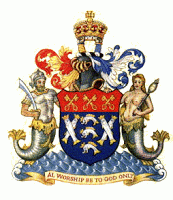 Arms of Worshipful Company of FishmongersWilliam Dyer (1609-1677) wasthe son of Lincolnshire farmers, and apprenticedto a Londonleather-goods trader in the Worshipful Company of Fishmongers for nine years.When he completed his service, you might consider his education on a par with aMaster's Degree in Business Administration, with emphasis in internationalimport/export. Many men who belonged to this Fishmongers guild had become London council membersand Lord Mayors.
Arms of Worshipful Company of FishmongersWilliam Dyer (1609-1677) wasthe son of Lincolnshire farmers, and apprenticedto a Londonleather-goods trader in the Worshipful Company of Fishmongers for nine years.When he completed his service, you might consider his education on a par with aMaster's Degree in Business Administration, with emphasis in internationalimport/export. Many men who belonged to this Fishmongers guild had become London council membersand Lord Mayors.
Dyer and his wife (MaryBarrett Dyer) emigrated to Bostonin 1635, but were excommunicated for their religious and political beliefs inearly 1638. Governor John Winthrop described William Dyer, at about age 25, as asuccessful businessman from London.Winthrop alsocalled Mary Dyer "Mistress Dyer," which carried a much higher status andrespect than the usual "goodwife" or use of the first name only. But later, Winthrop describedWilliam as "having little to say"for himself, and "apt to meddle inpublike affairs, beyond his calling and skill;" and that he shuffled and equivocated when underscrutiny.
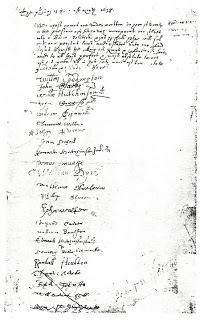
William Dyer co-founded Portsmouth and Newport, Rhode Island. (See image: Portsmouth Compact of 1638, probably in William Dyer's hand, as he was clerk and recorder. His signature is halfway down the page, as "William Dyre.")
Over the next fourteen years, William served as clerk and secretary to thecourts, and was a militia captain. From 1650 to 1653, he served as Rhode Island's first attorney general, and wasinstrumental in obtaining the colony charters for democratic self-governmentand separation of civil and church powers.
Dyer was commissioned NewEngland's first admiral in 1652 bySir Henry Vane the Younger, British naval commissioner and at times, Presidentof the Council of State when Great Britain was between monarchs during theCommonwealth and Protectorate.
On October 1, 1652, a letterwas written from the British naval commission to the Colony of Rhode Island in New England, to give them power to stay Dutch ships andto appoint some fit person to take care of and preserve them for the State.
As soon as Dyer returned to Rhode Island from England, he began to prepare forwar. Dyer, Nicholas Easton, and John Sanford created New England's first Court of Admiralty.And Admiral Dyer was chosen to be on a committee of seven to fortify and arm Newport. His large horseand tobacco farm property is now covered by the United States Naval War College.
On May 17, 1653, Dyer wascommissioned Commander in Chief Upon theSeas by the United Colonies of New England; and Captain John Underhill wascommissioned Commander in Chief Upon the Land. They were charged with thedefense of Englishmen from the Dutch, and to take ships by "inducement," but toprevent the effusion of blood, and violence. Dyer and Underhill "assisted both to other for ye preparings of ye severallseizures for the honor of ye Commonwealth of England in which theyare employed." They were to work in concert, at land and sea.
On June 3, 1653, Admiral Dyerwas commissioned by Rhode Island (Newport only, where hewas a resident neighbor, land-owner, businessman, politician, and well-known) asa privateer (a government-licensed pirate) with the charge to seize any Dutchproperties claimed by the English. The more-distanttowns of Providence and Warwick, however, filed "A BriefRemonstrance" to disassociate themselves from what they believed were "illegal and unjust proceedings" of Dyer and his privateers.
Dutch maps made before theAnglo-Dutch war of 1652-54 show they claimed a large chunk of Massachusetts,Rhode Island, all of Connecticut, New Hampshire—any place they could put atrading post, they claimed as Dutch territory. According to the Englishcolonies, the Dutch were bribing the Indian tribes to kill the Englishsettlers. This belief appeared to be confirmed in 1643 when Anne Hutchinson and17 members of her family and friends were killed by Indians when they lived ona Dutch farm in what is now the Bronx.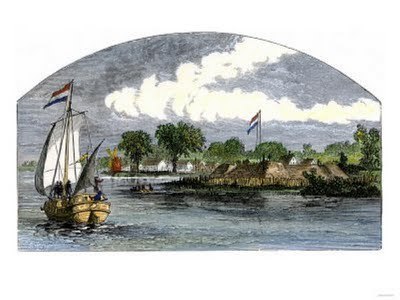 Ship passing House of Good Hope, at Hartford, Connecticut
Ship passing House of Good Hope, at Hartford, Connecticut
Among the first conquests ofDyer and Underhill was the Dutch West Indies trading post called House of GoodHope, on the Connecticut River at Hartford.In the Treaty at Hartford, September 19, 1650,between the Dutch and English, it had been agreed that the Dutch should remainin full possession of their lands on the fresh river at Hartford. But by the spring of 1653, theDutch trading post at Hartford,settled by Reverends Hooker and Stone, looked like shooting fish in a barrel. BothDyer and Underhill were extremely familiar with this property, and it appearsthat they may have had designs on it before their commissions were made.
Admiral William Dyer, age 44,was considered an opportunist, provocateur, and privateer by themembers of the United Colonies of New England—the very people who provided him withletters of marque! Along with Capt. John Underhill, he plundered Dutch andFrench ships and farms along the New Englandcoast, particularly Long Island Sound.
A number of ship captainssailed under the authority of Admiral Dyer, including Edward Hull and ThomasBaxter, both of whom eventually came up on charges of piracy and overtakingtheir authority. They had seized the ships, cargos, and seaside farms of Massachusetts, Connecticutand Long Islanders who were not Dutch—only Englishmen suspected of trading withthe Dutch. Baxter had lived in New Amsterdam,and so he knew which ships and farms to plunder. Hullhad lived in Barnstable, Massachusetts,as well as Connecticut, Block Island, and Newport, and knew theports and the ships that plied the waters. They would raid not only Dutch, butFrench and other nations' ships in an apparent zeal of "hostile takeover first,ask questions later—if you can catch me." Baxter was known for pirating Dutchpossessions, then dashing for cover in Connecticutor Rhode Islandrivers. His exploits set an example for other unscrupulous men, and soon theLong Island Sound was heavily patrolled against pirates. A historian laterwrote that the Sound was "infested" with small-time pirates.
Hull and Baxter were involved in other shady dealings overthe course of two or three years. They were later ordered to make restitutionand pay punitive damages. Baxter was imprisoned and handed back to the Dutch atNew Amsterdam (Manhattan Island), but after a yearof incarceration, he escaped.
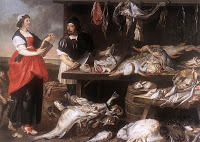 Loose fish in a Dutch fishmonger stallThomas Janvier, a historian,described Rhode Islandin those years and for many succeeding years, as "the abode of notoriously hard characters—even made a start on alittle war of spoliation on its own account." He referred to Capt. John Underhilland Admiral William Dyer as 'loose fishof thievish proclivities" with license from "that disreputable colony" [Rhode Island] to "take all Dutch ships and vessels as shallcome into their power."
Loose fish in a Dutch fishmonger stallThomas Janvier, a historian,described Rhode Islandin those years and for many succeeding years, as "the abode of notoriously hard characters—even made a start on alittle war of spoliation on its own account." He referred to Capt. John Underhilland Admiral William Dyer as 'loose fishof thievish proclivities" with license from "that disreputable colony" [Rhode Island] to "take all Dutch ships and vessels as shallcome into their power."
In the 1905 edition of The Dictionary of Phrase and Fable, byEbenezer Cobham Brewer, "Loose Fish" is defined as "A dissipated man. We alsospeak of a 'queer fish,' and the word 'fishy' means of very doubtful character.A loose fish is one that has made its way out of the net; and applied to man itmeans one who has thrown off moral restraint."
Thievish proclivities. Dissipated.Doubtful character. Rejected moral restraint. Hard characters. Fishy!
Though William Dyer is notoften mentioned as a man of firsts, and his wife Mary is much more famous asthe Quaker teacher who was hanged in Boston for her civil disobedience to thePuritan authorities, he did live a remarkable life as member of a prestigiousguild, a Boston pioneer, co-founder of Portsmouth and Newport, horse breeder,Newport harbor developer, international trader, militia captain, politician,Rhode Island's first attorney general, New England's first admiral andcommander in chief upon the seas, father of nine (seven of whom survivedinfancy)—and a licensed pirate. (Oh, dear!)
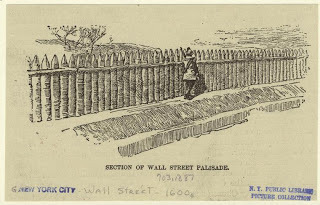 But there's one more thingyou should know about William Dyer: A meeting of the United Colonies noted thatDyre had 'quickly gathered around him a band of "resolute fellows" to fall onthe Dutch farmes.' New Amsterdam (now Lower Manhattan)built a defensive palisade across the island to defend themselves from land andsea raids by Indians and Englishmen (including the privateers under command ofDyer and Underhill). The wagon road running along the wooden palisade becameknown as Wall Street.
But there's one more thingyou should know about William Dyer: A meeting of the United Colonies noted thatDyre had 'quickly gathered around him a band of "resolute fellows" to fall onthe Dutch farmes.' New Amsterdam (now Lower Manhattan)built a defensive palisade across the island to defend themselves from land andsea raids by Indians and Englishmen (including the privateers under command ofDyer and Underhill). The wagon road running along the wooden palisade becameknown as Wall Street.
Wall Street: the spiritual home of corporate raiders. Oh,the irony.
 Arms of Worshipful Company of FishmongersWilliam Dyer (1609-1677) wasthe son of Lincolnshire farmers, and apprenticedto a Londonleather-goods trader in the Worshipful Company of Fishmongers for nine years.When he completed his service, you might consider his education on a par with aMaster's Degree in Business Administration, with emphasis in internationalimport/export. Many men who belonged to this Fishmongers guild had become London council membersand Lord Mayors.
Arms of Worshipful Company of FishmongersWilliam Dyer (1609-1677) wasthe son of Lincolnshire farmers, and apprenticedto a Londonleather-goods trader in the Worshipful Company of Fishmongers for nine years.When he completed his service, you might consider his education on a par with aMaster's Degree in Business Administration, with emphasis in internationalimport/export. Many men who belonged to this Fishmongers guild had become London council membersand Lord Mayors. Dyer and his wife (MaryBarrett Dyer) emigrated to Bostonin 1635, but were excommunicated for their religious and political beliefs inearly 1638. Governor John Winthrop described William Dyer, at about age 25, as asuccessful businessman from London.Winthrop alsocalled Mary Dyer "Mistress Dyer," which carried a much higher status andrespect than the usual "goodwife" or use of the first name only. But later, Winthrop describedWilliam as "having little to say"for himself, and "apt to meddle inpublike affairs, beyond his calling and skill;" and that he shuffled and equivocated when underscrutiny.

William Dyer co-founded Portsmouth and Newport, Rhode Island. (See image: Portsmouth Compact of 1638, probably in William Dyer's hand, as he was clerk and recorder. His signature is halfway down the page, as "William Dyre.")
Over the next fourteen years, William served as clerk and secretary to thecourts, and was a militia captain. From 1650 to 1653, he served as Rhode Island's first attorney general, and wasinstrumental in obtaining the colony charters for democratic self-governmentand separation of civil and church powers.
Dyer was commissioned NewEngland's first admiral in 1652 bySir Henry Vane the Younger, British naval commissioner and at times, Presidentof the Council of State when Great Britain was between monarchs during theCommonwealth and Protectorate.
On October 1, 1652, a letterwas written from the British naval commission to the Colony of Rhode Island in New England, to give them power to stay Dutch ships andto appoint some fit person to take care of and preserve them for the State.
As soon as Dyer returned to Rhode Island from England, he began to prepare forwar. Dyer, Nicholas Easton, and John Sanford created New England's first Court of Admiralty.And Admiral Dyer was chosen to be on a committee of seven to fortify and arm Newport. His large horseand tobacco farm property is now covered by the United States Naval War College.
On May 17, 1653, Dyer wascommissioned Commander in Chief Upon theSeas by the United Colonies of New England; and Captain John Underhill wascommissioned Commander in Chief Upon the Land. They were charged with thedefense of Englishmen from the Dutch, and to take ships by "inducement," but toprevent the effusion of blood, and violence. Dyer and Underhill "assisted both to other for ye preparings of ye severallseizures for the honor of ye Commonwealth of England in which theyare employed." They were to work in concert, at land and sea.
On June 3, 1653, Admiral Dyerwas commissioned by Rhode Island (Newport only, where hewas a resident neighbor, land-owner, businessman, politician, and well-known) asa privateer (a government-licensed pirate) with the charge to seize any Dutchproperties claimed by the English. The more-distanttowns of Providence and Warwick, however, filed "A BriefRemonstrance" to disassociate themselves from what they believed were "illegal and unjust proceedings" of Dyer and his privateers.
Dutch maps made before theAnglo-Dutch war of 1652-54 show they claimed a large chunk of Massachusetts,Rhode Island, all of Connecticut, New Hampshire—any place they could put atrading post, they claimed as Dutch territory. According to the Englishcolonies, the Dutch were bribing the Indian tribes to kill the Englishsettlers. This belief appeared to be confirmed in 1643 when Anne Hutchinson and17 members of her family and friends were killed by Indians when they lived ona Dutch farm in what is now the Bronx.
 Ship passing House of Good Hope, at Hartford, Connecticut
Ship passing House of Good Hope, at Hartford, Connecticut Among the first conquests ofDyer and Underhill was the Dutch West Indies trading post called House of GoodHope, on the Connecticut River at Hartford.In the Treaty at Hartford, September 19, 1650,between the Dutch and English, it had been agreed that the Dutch should remainin full possession of their lands on the fresh river at Hartford. But by the spring of 1653, theDutch trading post at Hartford,settled by Reverends Hooker and Stone, looked like shooting fish in a barrel. BothDyer and Underhill were extremely familiar with this property, and it appearsthat they may have had designs on it before their commissions were made.
Admiral William Dyer, age 44,was considered an opportunist, provocateur, and privateer by themembers of the United Colonies of New England—the very people who provided him withletters of marque! Along with Capt. John Underhill, he plundered Dutch andFrench ships and farms along the New Englandcoast, particularly Long Island Sound.
A number of ship captainssailed under the authority of Admiral Dyer, including Edward Hull and ThomasBaxter, both of whom eventually came up on charges of piracy and overtakingtheir authority. They had seized the ships, cargos, and seaside farms of Massachusetts, Connecticutand Long Islanders who were not Dutch—only Englishmen suspected of trading withthe Dutch. Baxter had lived in New Amsterdam,and so he knew which ships and farms to plunder. Hullhad lived in Barnstable, Massachusetts,as well as Connecticut, Block Island, and Newport, and knew theports and the ships that plied the waters. They would raid not only Dutch, butFrench and other nations' ships in an apparent zeal of "hostile takeover first,ask questions later—if you can catch me." Baxter was known for pirating Dutchpossessions, then dashing for cover in Connecticutor Rhode Islandrivers. His exploits set an example for other unscrupulous men, and soon theLong Island Sound was heavily patrolled against pirates. A historian laterwrote that the Sound was "infested" with small-time pirates.
Hull and Baxter were involved in other shady dealings overthe course of two or three years. They were later ordered to make restitutionand pay punitive damages. Baxter was imprisoned and handed back to the Dutch atNew Amsterdam (Manhattan Island), but after a yearof incarceration, he escaped.
 Loose fish in a Dutch fishmonger stallThomas Janvier, a historian,described Rhode Islandin those years and for many succeeding years, as "the abode of notoriously hard characters—even made a start on alittle war of spoliation on its own account." He referred to Capt. John Underhilland Admiral William Dyer as 'loose fishof thievish proclivities" with license from "that disreputable colony" [Rhode Island] to "take all Dutch ships and vessels as shallcome into their power."
Loose fish in a Dutch fishmonger stallThomas Janvier, a historian,described Rhode Islandin those years and for many succeeding years, as "the abode of notoriously hard characters—even made a start on alittle war of spoliation on its own account." He referred to Capt. John Underhilland Admiral William Dyer as 'loose fishof thievish proclivities" with license from "that disreputable colony" [Rhode Island] to "take all Dutch ships and vessels as shallcome into their power." In the 1905 edition of The Dictionary of Phrase and Fable, byEbenezer Cobham Brewer, "Loose Fish" is defined as "A dissipated man. We alsospeak of a 'queer fish,' and the word 'fishy' means of very doubtful character.A loose fish is one that has made its way out of the net; and applied to man itmeans one who has thrown off moral restraint."
Thievish proclivities. Dissipated.Doubtful character. Rejected moral restraint. Hard characters. Fishy!
Though William Dyer is notoften mentioned as a man of firsts, and his wife Mary is much more famous asthe Quaker teacher who was hanged in Boston for her civil disobedience to thePuritan authorities, he did live a remarkable life as member of a prestigiousguild, a Boston pioneer, co-founder of Portsmouth and Newport, horse breeder,Newport harbor developer, international trader, militia captain, politician,Rhode Island's first attorney general, New England's first admiral andcommander in chief upon the seas, father of nine (seven of whom survivedinfancy)—and a licensed pirate. (Oh, dear!)
 But there's one more thingyou should know about William Dyer: A meeting of the United Colonies noted thatDyre had 'quickly gathered around him a band of "resolute fellows" to fall onthe Dutch farmes.' New Amsterdam (now Lower Manhattan)built a defensive palisade across the island to defend themselves from land andsea raids by Indians and Englishmen (including the privateers under command ofDyer and Underhill). The wagon road running along the wooden palisade becameknown as Wall Street.
But there's one more thingyou should know about William Dyer: A meeting of the United Colonies noted thatDyre had 'quickly gathered around him a band of "resolute fellows" to fall onthe Dutch farmes.' New Amsterdam (now Lower Manhattan)built a defensive palisade across the island to defend themselves from land andsea raids by Indians and Englishmen (including the privateers under command ofDyer and Underhill). The wagon road running along the wooden palisade becameknown as Wall Street. Wall Street: the spiritual home of corporate raiders. Oh,the irony.
Published on September 01, 2011 01:00
August 31, 2011
Where is God when we suffer?
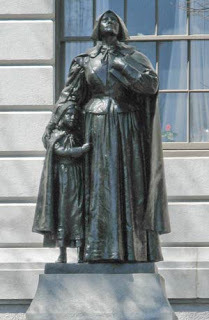 Statue of Anne Hutchinson at BostonWhy does God allow suffering, even with children? Why aren't God's people shielded from persecution and death?
Statue of Anne Hutchinson at BostonWhy does God allow suffering, even with children? Why aren't God's people shielded from persecution and death?That's the current question in the novel I'm writing on Mary Barrett Dyer. On August 20, 1643, Mary's mentor and close friend, Anne Marbury Hutchinson (the antinomian religious leader exiled from Puritan Boston), and five of her children were massacred by the Siwanoy Indians they'd come to evangelize. One daughter was abducted by the Indians and returned a few years later in a negotiated settlement.
Mary Dyer heard about it a few weeks later, and the news probably brought on labor and childbirth. She named her newborn son "Maher-shallal-hash-baz," and called him Maher. (The other children had "normal" names like Samuel, William, Mary, Henry, and Charles.) I went digging for the meaning of Maher's name. It comes from Isaiah 8:4, and means, in Hebrew, "suddenly attacked, quickly taken" or "swift to plunder and quick to carry away."
Mary Dyer named her son in a time of grief and despair over the deaths of Anne and the children, in a sudden and vicious attack where an innocent girl was carried away. Mary's question surely would have been, Why did God allow such a tragedy, when Anne was such a strong witness for him?
"Remember those earlier days after you had received the light when you stood your ground in a great contest in the face of suffering. Sometimes you were publicly exposed to insult and persecution; at other times you stood side by side with those who were so treated. You sympathized with those in prison and joyfully accepted the confiscation of your property, because you knew that you yourselves had better and lasting possessions. So do not throw away your confidence; it will be richly rewarded. You need to persevere so that when you have done the will of God, you will receive what he has promised." Hebrews 10:32-36 NIV
What was the promise?
Long before Mary Dyer died on a gallows in 1660 for civil disobedience and in the cause of religious freedom, she had found the answer for herself. Mary knew what sustained Abraham, Job, Moses, David, Solomon, and all the heroes of faith listed in Hebrews chapter 11. She understood that God is sovereign, and we are his trusting children. And she knew the Bible promises were not of a mansion or riches in heaven, not of a bubble of safety and prosperity, but of intimacy with God, for all eternity. Intimacy begun in a garden where Adam and Eve walked with God and talked face to face. Intimacy restored in part by the incarnation of Jesus Christ, the temple veil to the Holy of Holies being torn to allow us access to God's mercy, and the miracle of the Holy Spirit speaking in our hearts. And intimacy restored fully by the reunion we'll celebrate when Immanuel, God With Us, tenderly wipes away our tears and takes us to his heart forever.
Mary Barrett Dyer knew that although suffering in this life is terrible for both victims and the survivors who love them, that God brings us through it together with him, that one day we'll know why the pain was allowed, and that because of the surpassing glory of that day, we'll look back and consider our human suffering as a split-second of learning and growing deep in trust.
Mary was already experiencing the bliss of that intimacy while she was lying on a prison's dirt floor before her execution, when she wrote "he gloriously accompanied with his Presence, and Peace, and Love in me, in which I rested from my labour..."
Where was God? Inside her. All around her. Holding her in his arms. Welcoming her to eternity with him.
Published on August 31, 2011 23:53
Mary Dyer and freedom of conscience
"It is not the glorious battlements, the painted windows, the crouching gargoyles that support a building, but the stones that lie unseen in or upon the earth. It is often those who are despised and trampled on that bear up the weight of a whole nation." ~John Owen, English Puritan minister, 1616–1683.
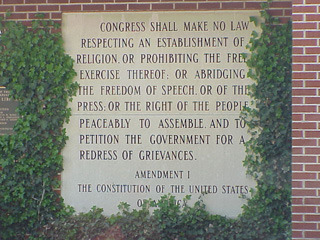 June 1, 1660 was a landmark date in American history. Its relation to civil rights guaranteed by the US Constitution's Bill of Rights should be noted, specifically the 1st Amendment regarding freedom of religion (to worship or not, as your own conscience dictates), and freedom of speech and assembly.
June 1, 1660 was a landmark date in American history. Its relation to civil rights guaranteed by the US Constitution's Bill of Rights should be noted, specifically the 1st Amendment regarding freedom of religion (to worship or not, as your own conscience dictates), and freedom of speech and assembly. Mary Barrett Dyer, hanged in Boston on June 1, 1660, was martyred for liberty of conscience that Americans enjoy under the Constitution's Bill of Rights. Other countries have modeled their constitutions and rights on those of the United States, so these liberties have become global.
In 2010, on the 350th anniversary of Mary Dyer's martyrdom, there was no mention of her in newspapers or online. No events in Boston, Rhode Island, or Washington, DC. No political or religious movements made mention of the sacrifice of the only female religious martyr in America.
Torture and persecutionIn the late 1650s, Quakers had been persecuted for their nonconformism by having their tongues bored with a hot awl; men and women were stripped bare to the waist and flogged with up to 30 strokes of the thrice-knotted lash, to add more injury to each stroke; they had their ears either nailed to a post, or sliced off altogether; without a trial, they were thrown in earthen-floored jail cells, sometimes for months, with no candle or heat in New England's harsh winters; prisoners were beaten several times a week. Even non-Quakers whose consciences were pricked by this harsh treatment were jailed, whipped, heavily fined, and disfranchised (lost their civil rights and vote) for harboring or sympathizing publicly with Quakers.
Contrary to popular opinion in genealogy sites, Mary Barrett Dyer wasn't hanged "for the crime of being a Quaker." It wasn't a crime to be a Quaker! However, they didn't attend Puritan worship or teaching services or pay required tithes, didn't keep the Sabbath holy, and criticized the government leaders for their cruelty. Mary Dyer provoked her own trials and execution for what we'd call civil disobedience, by repeatedly defying the totalitarian Puritan regime headed by Massachusetts Governor John Endecott. The Massachusetts Bay founders believed that religious error or dissent from their dogma was treasonable.
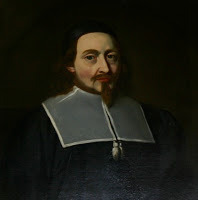 Endecott, a religious zealot, had a checkered past, leaving an illegitimate son in England before he emigrated to Salem, Massachusetts in 1629; treasonably cutting the "idolatrous" cross from the British flag; a Massachusetts committee reported in 1634 "that they apprehend [Endecott] had offended therein many ways, in rashness, uncharitableness, indiscretion and exceeding the limits of his calling;" acting in ways that endangered the patent that was their title to land in New England; creating a mint in Boston that made unauthorized—and therefore counterfeit—coins with a 1652 imprint for 30 years (so if the English government confiscated the minting, Boston could claim the coins were all from 1652 when they had little oversight during the English political upheaval); and punishing his indentured servant girl with 32 lash-stripes and public humiliation for fornication, bearing a child out of wedlock, and insistently naming his son as the predatory father (which, of course, would make John Endecott the father of a rapist and grandfather of a lowly servant's bastard—can't have that!).
Endecott, a religious zealot, had a checkered past, leaving an illegitimate son in England before he emigrated to Salem, Massachusetts in 1629; treasonably cutting the "idolatrous" cross from the British flag; a Massachusetts committee reported in 1634 "that they apprehend [Endecott] had offended therein many ways, in rashness, uncharitableness, indiscretion and exceeding the limits of his calling;" acting in ways that endangered the patent that was their title to land in New England; creating a mint in Boston that made unauthorized—and therefore counterfeit—coins with a 1652 imprint for 30 years (so if the English government confiscated the minting, Boston could claim the coins were all from 1652 when they had little oversight during the English political upheaval); and punishing his indentured servant girl with 32 lash-stripes and public humiliation for fornication, bearing a child out of wedlock, and insistently naming his son as the predatory father (which, of course, would make John Endecott the father of a rapist and grandfather of a lowly servant's bastard—can't have that!). 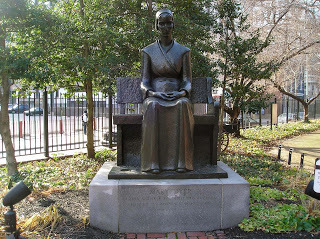 The colony and later state of Rhode Island was founded by Roger Williams in the 1630s as a haven for freedom of conscience, and that's where Mary and her husband and children made their home after being ejected from Massachusetts in 1637 over a religious matter prosecuted by the church state. Mary studied Quaker beliefs in England for several years, and returned to Boston only to be thrown into jail for 10 weeks with no notice to her husband in nearby Rhode Island.
The colony and later state of Rhode Island was founded by Roger Williams in the 1630s as a haven for freedom of conscience, and that's where Mary and her husband and children made their home after being ejected from Massachusetts in 1637 over a religious matter prosecuted by the church state. Mary studied Quaker beliefs in England for several years, and returned to Boston only to be thrown into jail for 10 weeks with no notice to her husband in nearby Rhode Island. Though Mary could have lived out her life in safety, she believed she was called by God to try the bloody religious laws of Connecticut and Massachusetts, and she boldly entered their territory to both teach, and support her Friends in the faith by visiting them in prison.
Prepared to dieHer letters written from Boston prison to Governor Endecott, her actions, and her statements at trial demonstrate to us that she willingly sacrificed her life to stop the torture and persecution of people who were obeying the voice of God in their hearts. She wrote, "Be not found Fighters against God, but let my Counsel and Request be accepted with you, To repeal all such Laws, that the Truth and Servants of the Lord, may have free Passage among you and you be kept from shedding innocent Blood…My life is not accepted, neither availeth me, in Comparison of the Lives and Liberty of the Truth and Servants of the Living God… yet nevertheless, with wicked Hands have you put two of them to Death, which makes me to feel, that the Mercies of the Wicked is Cruelty. I rather choose to die than to live, as from you, as Guilty of their innocent Blood… Therefore I leave these Lines with you, appealing to the faithful and true Witness of God, which is One in all Consciences, before whom we must all appear; with whom I shall eternally rest, in Everlasting Joy and Peace, whether you will hear or forebear: With him is my Reward, with whom to live is my Joy, and to die is my Gain."
Knowing that there was a death sentence hanging over her, she deliberately avoided her husband who would have stopped her, and returned to Boston, where she was arrested and jailed. She was convicted and condemned on May 31, 1660, and was hanged the next day, on June 1.
The shock over Mary Dyer's death crossed the Atlantic immediately, and King Charles II put an end to the New England death penalty for religious practice, requiring that capital cases be tried in England. Public outrage in New England over Mary's death actually consolidated sympathy for Quakers, Baptists, Jews, and others who refused to conform to Puritanism. Even some of the New England Puritans demonstrated their opposition to the harsh treatment of people of conscience, and suffered imprisonment, banishment, confiscation of property, and heavy fines. A number of those who'd suffered persecution converted to the Quaker faith. Gradually, the torture and persecution slowed.
William Dyer's name appears on the 1663 royal charter granting rights of freedom of religion to Rhode Island colony. He and several others had worked closely with Dr. John Clarke of Newport, the architect of the document, to preserve the separation of church and state, and promote the freedom of conscience. One hundred thirty years later, the concept became concrete in the US Constitution's Bill of Rights, Amendment I.
To learn more about the Dyers' life, join her Facebook friends.
Published on August 31, 2011 23:47
The establishment vs the individual: Mary Barrett Dyer
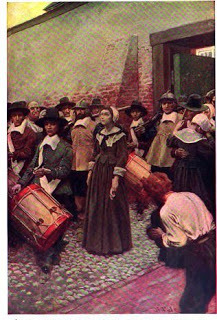 "The sentence was passed upon you; you must return to the prison and there remain until tomorrow at nine o'clock; then from thence you must go to the gallows, and there be hanged till you are dead." ~Gov John Endicott, Massachusetts Bay Colony--said to Mary Barrett Dyer, my ancestor, May 31, 1660, 350 years ago.
"The sentence was passed upon you; you must return to the prison and there remain until tomorrow at nine o'clock; then from thence you must go to the gallows, and there be hanged till you are dead." ~Gov John Endicott, Massachusetts Bay Colony--said to Mary Barrett Dyer, my ancestor, May 31, 1660, 350 years ago.And on June 1, 1660, Mary was taken from the jailhouse to the gallows on Boston Common. So that the large crowd of onlookers would not be able to hear her voice, drummers accompanied the militia as she walked the mile to the gallows where she died.
_____________ Mary Dyer was banished from Boston for her religious beliefs, but kept returning under conviction that she must speak what God revealed to her. The first occasion was as an Antinomian in 1638. The Puritans who governed Massachusetts Bay Colony were themselves refugees from the Anglican repression of Calvinism. They believed that civil and religious government were one fabric, and based their civil laws upon the Ten Commandments. They believed also that they were special and chosen of God, and that their piety and strict adherence to the Law proved to each other and to God that they were, indeed, predestined for eternal salvation.
This may seem foreign to contemporary Protestants and evangelicals who believe that salvation is only by God's gift—grace—to anyone and everyone who accepts the gift. But there are many people and groups today who say that yes, they're saved by grace, but because they love the Lord who saves them, they must "prove" their love by keeping the law of the Old Testament. They misunderstand Jesus' statement, "If you love me, keep my commands," because it's taken out of context. Jesus' command (not the Ten Commandments) in that context is simply to love one another as he loves us.
Antinomians believed that the Bible's entire Old Testament law (nomos in Greek) was made null and void when Jesus died on the cross. There was no distinction between the ceremonial regulations (sacrifices and rituals, clean/unclean activities and foods) and the moral law (Ten Commandments). Nomos meant the entire kit and caboodle.
As believers in Jesus, Christians are no longer under the covenant of keeping the Law, Antinomians believed.
"For sin shall not be master over you, for you are not under law but under grace." Romans 6:14
"But now, by dying to what once bound us, we have been released from the law so that we serve in the new way of the Spirit, and not in the old way of the written code." Romans 7:6
"Through Christ Jesus the law of the Spirit of life set me free from the law of sin and death." Romans 8:2
"By calling this covenant "new," he has made the first one obsolete; and what is obsolete and aging will soon disappear." Hebrews 8:13
So if we don't keep the old Law any more, are we free to participate in chaos, and do as we please, hurting ourselves and others? No, says Paul the apostle. Now we are accountable directly to God himself, subject to the new Law he writes on our minds and hearts (conscience). We have lists in the New Testament of behaviors and attitudes which will keep us from intimacy with God, and keep us from entering his kingdom: murder, fornication and adultery (sex outside marriage), theft, lying, gossip and slander, dishonoring our parents, greed, drunkenness, and others.
"For this is the covenant that I will make with the house of Israel after those days, saith the Lord; I will put my laws into their mind, and write them in their hearts [direct revelation or Inner Light]: and I will be to them a God, and they shall be to me a people: And they shall not teach every man his neighbour, and every man his brother, saying, Know the Lord: for all shall know me, from the least to the greatest [there goes the theory of the Elect]. For I will be merciful to their unrighteousness, and their sins and their iniquities will I remember no more." Hebrews 8:10-12
Here is where Mary Dyer and other Antinomians based their beliefs that the old Law was obsolete and useless, and the new Law was personally and directly revealed to them by the Holy Spirit. In later years, when Mary espoused the Quaker beliefs, direct revelation was called the Inner Light.
But back to the Puritans: If you destroy the foundation of their belief, the Law, there is nothing left to hold onto, because faith in God's grace is not enough security. You just cannot have people running around doing as they please, excusing themselves by saying that God told them to do this or that. There needs to be a structure! There's nothing that distinguishes the law-keepers from the Catholic or apostate-Protestant herds. The entire multibillion-dollar institution crashes. The worldwide "we're the exclusive Remnant/Elect of God, and only we will be saved" thing is gone. They can't handle it spiritually, emotionally, or intellectually. They also can't handle it financially. The Massachusetts Bay Colony was a business venture, chartered by King Charles I.
I understand, in a way. When you've believed wholeheartedly in God's will, that this promise or this distinctive is a special gift to you, it's part of your very fabric. Pull some threads or cut a hole, and it's not salvageable. It's too difficult, and maybe even too late in life, to start all over and learn everything new, especially when you've been "right." How does one hold one's head up with constituents, parishioners, faith adherents? There's no putting new wine into an old wineskin or patching a cotton tear with wool. What about prophesied end-time events? We've been denying ourselves and living a hard life, and these unworthy people get to waltz into heaven while we trudge there? What about judgment (who flies and who fries)? What if we stop observing a law-decreed Sabbath on Saturday or Sunday--and start trusting in God for complete rest from our strivings and a sabbath-rest that blesses us today and every day? What will distinguish us, the Remnant and the Elect, from the unwashed and uncouth? We'd have to go out of business, retrain every pastor, retool every institution from preschool through university and seminary, and worst of all, change the minds and hearts of those who have believed what they were taught for generations. It's unthinkable!
Puritans were so sure they were "right" that there was no room for dissent. (This from reformers and dissenters to the Church of England!) There was no agreeing to disagree. There was only consensus—agreeing to agree. And if, after being shown your errors in theology and behavior, you didn't agree, you'd be punished. The church/state government, and all of society, was in danger of collapse if people just did and believed as they wanted.
In 1637-38, Mary and William Dyer and 75 other families followed Anne Hutchinson in the Antinomian Controversy, and were disfellowshipped (excommunicated or disfranchised) from the Puritan congregations of Boston.
They moved to Rhode Island and founded two communities, Portsmouth and Newport, under extremely primitive conditions. They built homes and planted farms and worshiped according to conscience. Four years later, Massachusetts Governor Winthrop sent a manuscript to England that was published as a lurid and vicious description of Mary's stillborn anencephalic baby, and Anne Hutchinson's hydatidiform mole pregnancy, and called them monsters, proof of their heresy in 1637-38. (It was a Winthrop PR campaign to show his awesomeness and worthiness to be the governor of the colony.)
In 1652, Mary traveled back to England and stayed for five years. She followed the doctrines of George Fox, founder of the Quaker (Religious Society of Friends) movement, and sailed back to Rhode Island via Boston Harbor in 1657. She and her friends were arrested from shipboard and taken to prison, where they stayed for several months. Their crime: being Quakers, when the colony, now governed by John Endicott, had ruled that Quakers would be imprisoned and banished—after having been dragged behind a wagon and scourged, and losing their ears. One of Mary's shipmates, a woman, was stripped to the waist and scourged, and another was sent back to England, but Mary was released to her husband in Rhode Island as a professional courtesy because he was a government official—and not a Quaker.
Mary returned to Massachusetts in 1658 to visit her imprisoned Quaker friends and was expelled. She preached in New Haven, Connecticut, and was arrested and expelled from that colony. In 1659, she learned that two Quaker men had been imprisoned in Boston, and she walked through the forest on Indian trails to visit and comfort them in prison. She was arrested again, and tried in Governor Endicott's court. Mary was convicted and actually sent to the gallows. Her friends were hanged before she was placed in the noose with a cloth over her face—but was reprieved on condition she would not return to Boston. She actually seemed disappointed in the reprieve and "rescue" by her husband and eldest son, as she was protesting religious repression and willing to die with her Quaker colleagues. She was admonished not to return upon pain of death.
After six months of preaching to the Indians and Quakers of Long Island and Connecticut, she went back to Boston without telling her husband or six children who lived in Rhode Island. Her Quaker brothers and sisters were being tortured and their property confiscated. She went directly to the jail and asked to speak to the prisoners. She was arrested, jailed for more than a month, convicted again, and hanged on June 1, 1660.
Why did Mary seem to have a death wish? She had a husband who loved her, and six children, aged 10 to 25, yet she didn't stay with them very much during the two years before her execution, and after her five-year absence in England.
Analyzing her beliefs and letters, Mary Dyer seemed to have the biblical book of Hebrews written on her heart. This passage jumped out at me today as I was researching this post. I've bolded the phrases that apply to Mary, and you can see how closely they align with her actions just before her arrests, imprisonments, and execution.
"Remember those earlier days after you had received the light [direct revelation of God, or the Quaker "Inner Light"] when you stood your ground in a great contest in the face of suffering. Sometimes you were publicly exposed to insult and persecution; at other times you stood side by side with those who were so treated. You sympathized with those in prison and joyfully accepted the confiscation of your property, because you knew that you yourselves had better and lasting possessions. So do not throw away your confidence; it will be richly rewarded. You need to persevere so that when you have done the will of God, you will receive what he has promised." Hebrews 10:32-36
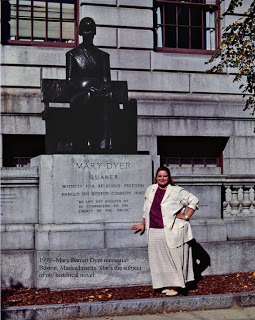 Mary joyfully accepted her martyrdom, believing that her death would so shock the system that Endicott and his court would have to back down from their repression. She died so that others could live and worship in freedom of conscience. She did not die in vain.
Mary joyfully accepted her martyrdom, believing that her death would so shock the system that Endicott and his court would have to back down from their repression. She died so that others could live and worship in freedom of conscience. She did not die in vain. The dedication on Mary's statue in Boston says "WITNESS FOR RELIGIOUS FREEDOM." Mary died for the basic human right to worship and express her religious beliefs as she felt called by God to do. She was the only woman hanged for religious beliefs, and only one more Quaker man was hanged after her, because of outcry in both New England and Britain over their persecution and executions.
Massachusetts Bay Colony, like many business, political, and religious organizations, was dedicated to control of the institution (self preservation), the church, and its people en masse. Mary understood that Jesus came as a man to relate to and save the individual. She and the others died for one of the principles America holds most dear: the liberty of the individual to follow conscience.
Published on August 31, 2011 23:32
Dyers' family timeline
TO LEARN MORE ABOUT MARY AND WILLIAM DYER, "FRIEND" THEM ON FACEBOOK. IF YOU'RE A DESCENDANT, PLEASE LEAVE A MESSAGE ON THE WALL.
Mary Barrett and William Dyer
Mary Barrett Dyer was an American pioneer, city co-founder, Puritan and Antinomian Bible study leader, Quaker minister, wife, mother of five living children, expelled from Massachusetts Colony six times, was twice taken bound to the scaffold, and finally executed by hanging for civil disobedience--NOT for "being a Quaker," as many websites declare. A memorial statue of Mary is located at the Massachusetts State House facing the Boston Common.
William's and Mary's timeline:.....William Dyer born/baptized: 19 Sep 1609, Kirkby Lathrope, Lincolnshire, England. This is modern Kirkby La Thorpe, between Sleaford and Boston. .....1611? Mary Barrett born. No record of parents or birthplace......1625 William apprenticed at age 16 as fishmonger in London, retroactive to 1624. The Worshipful Company of Fishmongers guild was considered prestigious. .....10-27-1633 After his 9 years of apprenticeship, Mary Barrett (approx age 22) marries William Dyer at St Martin in the Fields church, London. William is milliner selling scabbards, leather goods, etc. in New Exchange (a high-end shopping mall near the Strand). This is less than a mile from St Martin in the Fields church, in which parish they lived. [image error] .....10-24-1634 Son William born/baptized in London, buried 3 days later on his parents' first wedding anniversary. This church was destroyed in London's Great Fire, and rebuilt in a baroque design. However, the marble baptismal font and a wooden trunk predating the fire survive to the present......1634/1635 winter. William and Mary emigrate to Boston......3-3-1635 William takes Freeman oath in Boston......1635 summer. 39,000 people die in plague epidemic in London......10-20-1635 Son Samuel born and baptized in Boston......1635/6 William granted land in Chelsea, Massachusetts......1636 Mary joins Anne Marbury Hutchinson (whom William's family knew in Lincolnshire) in "heresy" that God speaks intimately to people ("Light"), that we are saved by faith not good works, that Christians are not bound by the moral law (antinomianism), that women and men are equal before God, that each individual should interpret law by own conscience, that Indian slavery was wrong (against Massachusetts Bay Company policy); Mary organizes women's study/discussion groups, antagonizing Gov Winthrop.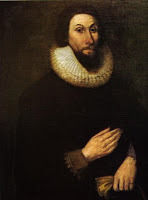 .....10-17-1637 Mary gave birth to stillborn, deformed baby girl, two months prematurely. Anne Hutchinson is midwife. Based on Winthrop's description, baby had anencephaly and other malformations, according to a neurologist......11-15-1637 William disfranchised from First Church of Boston for "seditious writing." Gov Winthrop says, "The wife of one William Dyer, a milliner in the New Exchange, a very proper and fair woman, and both of them notoriously infected with Mrs. Hutchinson's errors and very censorious and troublesome.".....1638 Dyers and Hutchinsons banished from Boston, have deadline of May 1 to be out of Boston. They move to found Portsmouth, Rhode Island......3-?-1638 In March, Gov Winthrop learns of stillborn baby. Probably at spring thaw, "monster" baby exhumed by Gov Winthrop; baby's deformity called evidence that Mary was heretic. .....3-7-1638 William signs Portsmouth Compact. Becomes clerk of Portsmouth......March 1639 Dyers move to southern part of Aquidneck Island and co-found Newport. .....1640 Son William (second child by that name) born in Newport, Rhode Island......1642 and 1644 Governor Winthrop's account of stillborn baby's deformation published in England. (English tabloid journalism!) .....1643 Son Mahershallalhashbaz born Newport, Rhode Island.....1647 Son Henry born Newport, Rhode Island.....1648 or 1649 Daughter Mary born Newport, Rhode Island......1650 William is Attorney General of Rhode Island......1650 Son Charles born Newport, Rhode Island. Charles is my ancestor. He is Mary's last child at about age 39-40......1652 William sails to England with Roger Williams, to revoke some of Gov Coddington's powers. William Dyer returns same year and continues political and civil career......1652 Sir Henry Vane the Younger commissions William Dyer as Admiral in the Anglo-Dutch War of 1652-54; United Colonies of New England commissions William Commander in Chief Upon the Seas for same war. .....January 1653 Mary sails for and stays in England almost five years, studying Quaker beliefs with George Fox, who preached all over England, but seems to have been based in the northwest part of England. More info on George Fox: http://www.strecorsoc.org/gfox/title.html This is the Parliamentary period, with Oliver Cromwell the Lord Protector ruling after execution of Charles I in 1649......1657 Mary sails back to America via Barbados, landing in Boston, unaware of Gov Endecott's new laws regarding Quakers. On arriving in Boston in 1657 she is imprisoned for 7-8 weeks in dirt-floored cell, depriving William of wife, and children of their mother. William writes eloquent and touching letter on her behalf; she is released. On the petition of her husband was permitted to go with him to Rhode Island, but never to return to Massachusetts......1658 Mary and William travel to Boston, protesting Gov Endecott's new law banning Quakers. Mary arrested and expelled from colony. William not arrested because he's not Quaker, and he's a public official in Rhode Island......1658 Mary arrested in New Haven, Connecticut for teaching......1659, summer. She walks through forest from Providence to Boston, a distance of 39 miles, to visit fellow Quakers in jail......1659, September. Mary arrested and permanently banished from Massachusetts Colony......1659, October. Mary returns to Boston to visit Quakers, arrested and sentenced to death. She, with William Robinson and Marmaduke Stevenson was tried and convicted for "their rebellion, sedition and presumptuous obtruding upon us notwithstanding their being sentenced to banishment on payne of death, as underminers of the government." Robinson and Stevenson were executed October 27, but through the petition of her son, William Dyre (son William was Mayor of New York in 1680 so accounts have his title as Mayor—but he was not Boston mayor at age 19), she was reprieved on the same conditions as before. Mary Dyer also stepped up the ladder, her face was covered and the halter put round her neck, when the cry was raised, "Stop! for she is reprieved." She was again banished. Released to custody of husband after husband William's 8-30-1659 letter and son William's October 1659 letter. Mary writes after the death of Robinson and Stevenson: "When I heard your last Order read, it was a disturbance unto me, that was so freely Offering up my life to him that give it me, and sent me hither to do, which Obedience being his own Work, he gloriously accompanied with his Presence, and Peace, and Love in me, in which I rested from my labour, till by your Order, and the People, I was so far disturbed, that I could not retain anymore of the words thereof, than that I should return to Prison, and there remain Forty and Eight hours; to which I submitted, finding nothing from the Lord to the contrary, that I may know what his Pleasure and Counsel is concerning me, on whom I wait therefore, for he is my Life, and the length of my Days, and as I said before, I came at his command, and go at His command."
.....10-17-1637 Mary gave birth to stillborn, deformed baby girl, two months prematurely. Anne Hutchinson is midwife. Based on Winthrop's description, baby had anencephaly and other malformations, according to a neurologist......11-15-1637 William disfranchised from First Church of Boston for "seditious writing." Gov Winthrop says, "The wife of one William Dyer, a milliner in the New Exchange, a very proper and fair woman, and both of them notoriously infected with Mrs. Hutchinson's errors and very censorious and troublesome.".....1638 Dyers and Hutchinsons banished from Boston, have deadline of May 1 to be out of Boston. They move to found Portsmouth, Rhode Island......3-?-1638 In March, Gov Winthrop learns of stillborn baby. Probably at spring thaw, "monster" baby exhumed by Gov Winthrop; baby's deformity called evidence that Mary was heretic. .....3-7-1638 William signs Portsmouth Compact. Becomes clerk of Portsmouth......March 1639 Dyers move to southern part of Aquidneck Island and co-found Newport. .....1640 Son William (second child by that name) born in Newport, Rhode Island......1642 and 1644 Governor Winthrop's account of stillborn baby's deformation published in England. (English tabloid journalism!) .....1643 Son Mahershallalhashbaz born Newport, Rhode Island.....1647 Son Henry born Newport, Rhode Island.....1648 or 1649 Daughter Mary born Newport, Rhode Island......1650 William is Attorney General of Rhode Island......1650 Son Charles born Newport, Rhode Island. Charles is my ancestor. He is Mary's last child at about age 39-40......1652 William sails to England with Roger Williams, to revoke some of Gov Coddington's powers. William Dyer returns same year and continues political and civil career......1652 Sir Henry Vane the Younger commissions William Dyer as Admiral in the Anglo-Dutch War of 1652-54; United Colonies of New England commissions William Commander in Chief Upon the Seas for same war. .....January 1653 Mary sails for and stays in England almost five years, studying Quaker beliefs with George Fox, who preached all over England, but seems to have been based in the northwest part of England. More info on George Fox: http://www.strecorsoc.org/gfox/title.html This is the Parliamentary period, with Oliver Cromwell the Lord Protector ruling after execution of Charles I in 1649......1657 Mary sails back to America via Barbados, landing in Boston, unaware of Gov Endecott's new laws regarding Quakers. On arriving in Boston in 1657 she is imprisoned for 7-8 weeks in dirt-floored cell, depriving William of wife, and children of their mother. William writes eloquent and touching letter on her behalf; she is released. On the petition of her husband was permitted to go with him to Rhode Island, but never to return to Massachusetts......1658 Mary and William travel to Boston, protesting Gov Endecott's new law banning Quakers. Mary arrested and expelled from colony. William not arrested because he's not Quaker, and he's a public official in Rhode Island......1658 Mary arrested in New Haven, Connecticut for teaching......1659, summer. She walks through forest from Providence to Boston, a distance of 39 miles, to visit fellow Quakers in jail......1659, September. Mary arrested and permanently banished from Massachusetts Colony......1659, October. Mary returns to Boston to visit Quakers, arrested and sentenced to death. She, with William Robinson and Marmaduke Stevenson was tried and convicted for "their rebellion, sedition and presumptuous obtruding upon us notwithstanding their being sentenced to banishment on payne of death, as underminers of the government." Robinson and Stevenson were executed October 27, but through the petition of her son, William Dyre (son William was Mayor of New York in 1680 so accounts have his title as Mayor—but he was not Boston mayor at age 19), she was reprieved on the same conditions as before. Mary Dyer also stepped up the ladder, her face was covered and the halter put round her neck, when the cry was raised, "Stop! for she is reprieved." She was again banished. Released to custody of husband after husband William's 8-30-1659 letter and son William's October 1659 letter. Mary writes after the death of Robinson and Stevenson: "When I heard your last Order read, it was a disturbance unto me, that was so freely Offering up my life to him that give it me, and sent me hither to do, which Obedience being his own Work, he gloriously accompanied with his Presence, and Peace, and Love in me, in which I rested from my labour, till by your Order, and the People, I was so far disturbed, that I could not retain anymore of the words thereof, than that I should return to Prison, and there remain Forty and Eight hours; to which I submitted, finding nothing from the Lord to the contrary, that I may know what his Pleasure and Counsel is concerning me, on whom I wait therefore, for he is my Life, and the length of my Days, and as I said before, I came at his command, and go at His command."
.....1659 Mary returns to Rhode Island, teaches Quaker beliefs on Long Island, New York. Also asked to teach Indians on Shelter Island......4-?-1660 Mary returns to Boston without telling husband. (She'd been expelled several times already.) Arrested......5-31-1660 Convicted, sentenced to death......6-1-1660 Mary hanged on Boston Common, aged about 49 years, leaving children aged 10 to 25......1661 William marries Catharine _______. Nothing is known of her......1662 William and Catharine have child Elizabeth......1677 William dies. .....1959 Memorial statue to Mary Barrett Dyer erected in Boston, facing the Common._______________________ Ancestry lines:William Dyer b. 1609, Lincolnshire......Father: William Dyer, farmer/landowner and church warden, son of John Dyer and Jane Ernley
.....Mother: Dorothy Shirley (possibly)
Mary Barrett of London (nothing is known of parents)Children of William and Mary (Barrett) Dyer:.....William, bapt. 24 Oct 1634; buried 27 Oct1634, London, England.....Samuel, bapt. 20 Oct 1635, Boston, MA; d. 1678, Kingstown, RI; m. abt 1660, Ann Hutchinson, granddaughter of Anne (Marbury) Hutchinson.....Stillborn daughter, 17 Oct 1637, Boston, MA.....William, b. abt 1640, Newport, RI; d. 1687/8; m. Mary Walker.....Mahershallalhashbaz, b. abt 1643, Newport, RI; d. bef 1670; m. Martha Pearce.....Henry, b. abt 1647, Newport, RI; d. Feb 1690; m. Elizabeth Sanford.....Mary, b. before 1650, Newport, RI; d. aft 26 Jan 1679, DE; m. by 1675, Henry Ward.....Charles, b. abt 1650, Newport, RI; d. May 15, 1727; m. (1) Mary Lippett; m. (2) Martha (Brownell) Wait___________Charles Dyer b. ~1650 Newport, Rhode Island d. 5-15-1709Spouse: (1) Mary Lippett, born 1650 died before 1690; married circa 1669 Newport probably daughter of John and Rebecca LippittSpouse (2) Martha Brownell born 5/1/1643 Portsmouth Newport RI died 2/15/1743-44 Portsmouth daughter of Thomas Brownell and Ann Bourne married 3/8/1690-91 Newport. Martha died childless at age 101 but raised Charles' children.
.....Children of Mary Lippett and Charles Dyer:1. James, born 1669 Little Compton Newport RI died circa 1735 Bucks Co. PA married Elizabeth ? 1696 in Little Compton;2. William, house carpenter, born circa 1671 Little Compton executed 4/21/1719 Newport RI for murder of his wife Hannah Briggs daughter of Thomas Briggs and Mary Fisher;3. Elizabeth born circa 1677 Little Compton died 7/1715 RI, married Tristram Hull 2/9/1698-99 son of Joseph Hull and Experience Harper;4. Charles, blacksmith, born circa 1685 Newport Newport RI, died 1/7/1626-7 Cranston Providence RI, married Mary Lapham 8/26/1709 Dartmouth Bristol MA daughter of John Lapham and Mary Mann;5. Samuel, born circa 1687 Little Compton died 9/15/1767 Newport Newport RI married Desire Slocum 1/19/1709-10 Jamestown Newport RI. Samuel cared for his stepmother Martha in her home until she died at age 101 in 1744. He raised his brother William's children after William murdered his wife and was executed in 1718. And Samuel may also have taken in Elizabeth Dyer Hull's children when she and her husband died in 1718 and 1719. ___________Elizabeth Dyer
m. 12-19-1698 in Newport, RI. Resided in South Kingston, RI. Died 1718.Tristram Hull b. 10-8-1677 d. 1719. Barnstable, Massachusetts. Son of Joseph Hull. ___________Bathsheba Hull May have been raised by her uncle Samuel Dyer in Newport, after her parents died.
Ebenezer Slocum ____________ Capt Edward Slocum, 1748-1822 Captain in Federal Army, American Revolutionary War.Unknown wife____________Oliver Wellington Slocum b. 1794Persis Felton (descendant of Rev. Samuel Skelton of Sempringham, Lincolnshire and Salem, Massachusetts) ____________Persis Slocum b. 1834 OhioAndrew Wolfe b. 1835 Ohio____________Mary Belle Wolfe b. 1872 Kansas d. 1960 Saskatchewan Hiram Frank Benner b. 1864 Ohio d. 1924 Estonia, Saskatchewan____________Reita Belle Benner b.1892 Hart, Michigan d. 1949 Owasso, Michigan Milo Francis Anson 1882-1960 ____________Andrew Allerton Anson 1914-1997Lois Elizabeth Stone 1913-1999____________Judith Louise Anson 1937-1993Kenneth Lee Robinson 1935- ____________Blog author Christy K Robinson

Mary Barrett and William Dyer
Mary Barrett Dyer was an American pioneer, city co-founder, Puritan and Antinomian Bible study leader, Quaker minister, wife, mother of five living children, expelled from Massachusetts Colony six times, was twice taken bound to the scaffold, and finally executed by hanging for civil disobedience--NOT for "being a Quaker," as many websites declare. A memorial statue of Mary is located at the Massachusetts State House facing the Boston Common.
William's and Mary's timeline:.....William Dyer born/baptized: 19 Sep 1609, Kirkby Lathrope, Lincolnshire, England. This is modern Kirkby La Thorpe, between Sleaford and Boston. .....1611? Mary Barrett born. No record of parents or birthplace......1625 William apprenticed at age 16 as fishmonger in London, retroactive to 1624. The Worshipful Company of Fishmongers guild was considered prestigious. .....10-27-1633 After his 9 years of apprenticeship, Mary Barrett (approx age 22) marries William Dyer at St Martin in the Fields church, London. William is milliner selling scabbards, leather goods, etc. in New Exchange (a high-end shopping mall near the Strand). This is less than a mile from St Martin in the Fields church, in which parish they lived. [image error] .....10-24-1634 Son William born/baptized in London, buried 3 days later on his parents' first wedding anniversary. This church was destroyed in London's Great Fire, and rebuilt in a baroque design. However, the marble baptismal font and a wooden trunk predating the fire survive to the present......1634/1635 winter. William and Mary emigrate to Boston......3-3-1635 William takes Freeman oath in Boston......1635 summer. 39,000 people die in plague epidemic in London......10-20-1635 Son Samuel born and baptized in Boston......1635/6 William granted land in Chelsea, Massachusetts......1636 Mary joins Anne Marbury Hutchinson (whom William's family knew in Lincolnshire) in "heresy" that God speaks intimately to people ("Light"), that we are saved by faith not good works, that Christians are not bound by the moral law (antinomianism), that women and men are equal before God, that each individual should interpret law by own conscience, that Indian slavery was wrong (against Massachusetts Bay Company policy); Mary organizes women's study/discussion groups, antagonizing Gov Winthrop.
 .....10-17-1637 Mary gave birth to stillborn, deformed baby girl, two months prematurely. Anne Hutchinson is midwife. Based on Winthrop's description, baby had anencephaly and other malformations, according to a neurologist......11-15-1637 William disfranchised from First Church of Boston for "seditious writing." Gov Winthrop says, "The wife of one William Dyer, a milliner in the New Exchange, a very proper and fair woman, and both of them notoriously infected with Mrs. Hutchinson's errors and very censorious and troublesome.".....1638 Dyers and Hutchinsons banished from Boston, have deadline of May 1 to be out of Boston. They move to found Portsmouth, Rhode Island......3-?-1638 In March, Gov Winthrop learns of stillborn baby. Probably at spring thaw, "monster" baby exhumed by Gov Winthrop; baby's deformity called evidence that Mary was heretic. .....3-7-1638 William signs Portsmouth Compact. Becomes clerk of Portsmouth......March 1639 Dyers move to southern part of Aquidneck Island and co-found Newport. .....1640 Son William (second child by that name) born in Newport, Rhode Island......1642 and 1644 Governor Winthrop's account of stillborn baby's deformation published in England. (English tabloid journalism!) .....1643 Son Mahershallalhashbaz born Newport, Rhode Island.....1647 Son Henry born Newport, Rhode Island.....1648 or 1649 Daughter Mary born Newport, Rhode Island......1650 William is Attorney General of Rhode Island......1650 Son Charles born Newport, Rhode Island. Charles is my ancestor. He is Mary's last child at about age 39-40......1652 William sails to England with Roger Williams, to revoke some of Gov Coddington's powers. William Dyer returns same year and continues political and civil career......1652 Sir Henry Vane the Younger commissions William Dyer as Admiral in the Anglo-Dutch War of 1652-54; United Colonies of New England commissions William Commander in Chief Upon the Seas for same war. .....January 1653 Mary sails for and stays in England almost five years, studying Quaker beliefs with George Fox, who preached all over England, but seems to have been based in the northwest part of England. More info on George Fox: http://www.strecorsoc.org/gfox/title.html This is the Parliamentary period, with Oliver Cromwell the Lord Protector ruling after execution of Charles I in 1649......1657 Mary sails back to America via Barbados, landing in Boston, unaware of Gov Endecott's new laws regarding Quakers. On arriving in Boston in 1657 she is imprisoned for 7-8 weeks in dirt-floored cell, depriving William of wife, and children of their mother. William writes eloquent and touching letter on her behalf; she is released. On the petition of her husband was permitted to go with him to Rhode Island, but never to return to Massachusetts......1658 Mary and William travel to Boston, protesting Gov Endecott's new law banning Quakers. Mary arrested and expelled from colony. William not arrested because he's not Quaker, and he's a public official in Rhode Island......1658 Mary arrested in New Haven, Connecticut for teaching......1659, summer. She walks through forest from Providence to Boston, a distance of 39 miles, to visit fellow Quakers in jail......1659, September. Mary arrested and permanently banished from Massachusetts Colony......1659, October. Mary returns to Boston to visit Quakers, arrested and sentenced to death. She, with William Robinson and Marmaduke Stevenson was tried and convicted for "their rebellion, sedition and presumptuous obtruding upon us notwithstanding their being sentenced to banishment on payne of death, as underminers of the government." Robinson and Stevenson were executed October 27, but through the petition of her son, William Dyre (son William was Mayor of New York in 1680 so accounts have his title as Mayor—but he was not Boston mayor at age 19), she was reprieved on the same conditions as before. Mary Dyer also stepped up the ladder, her face was covered and the halter put round her neck, when the cry was raised, "Stop! for she is reprieved." She was again banished. Released to custody of husband after husband William's 8-30-1659 letter and son William's October 1659 letter. Mary writes after the death of Robinson and Stevenson: "When I heard your last Order read, it was a disturbance unto me, that was so freely Offering up my life to him that give it me, and sent me hither to do, which Obedience being his own Work, he gloriously accompanied with his Presence, and Peace, and Love in me, in which I rested from my labour, till by your Order, and the People, I was so far disturbed, that I could not retain anymore of the words thereof, than that I should return to Prison, and there remain Forty and Eight hours; to which I submitted, finding nothing from the Lord to the contrary, that I may know what his Pleasure and Counsel is concerning me, on whom I wait therefore, for he is my Life, and the length of my Days, and as I said before, I came at his command, and go at His command."
.....10-17-1637 Mary gave birth to stillborn, deformed baby girl, two months prematurely. Anne Hutchinson is midwife. Based on Winthrop's description, baby had anencephaly and other malformations, according to a neurologist......11-15-1637 William disfranchised from First Church of Boston for "seditious writing." Gov Winthrop says, "The wife of one William Dyer, a milliner in the New Exchange, a very proper and fair woman, and both of them notoriously infected with Mrs. Hutchinson's errors and very censorious and troublesome.".....1638 Dyers and Hutchinsons banished from Boston, have deadline of May 1 to be out of Boston. They move to found Portsmouth, Rhode Island......3-?-1638 In March, Gov Winthrop learns of stillborn baby. Probably at spring thaw, "monster" baby exhumed by Gov Winthrop; baby's deformity called evidence that Mary was heretic. .....3-7-1638 William signs Portsmouth Compact. Becomes clerk of Portsmouth......March 1639 Dyers move to southern part of Aquidneck Island and co-found Newport. .....1640 Son William (second child by that name) born in Newport, Rhode Island......1642 and 1644 Governor Winthrop's account of stillborn baby's deformation published in England. (English tabloid journalism!) .....1643 Son Mahershallalhashbaz born Newport, Rhode Island.....1647 Son Henry born Newport, Rhode Island.....1648 or 1649 Daughter Mary born Newport, Rhode Island......1650 William is Attorney General of Rhode Island......1650 Son Charles born Newport, Rhode Island. Charles is my ancestor. He is Mary's last child at about age 39-40......1652 William sails to England with Roger Williams, to revoke some of Gov Coddington's powers. William Dyer returns same year and continues political and civil career......1652 Sir Henry Vane the Younger commissions William Dyer as Admiral in the Anglo-Dutch War of 1652-54; United Colonies of New England commissions William Commander in Chief Upon the Seas for same war. .....January 1653 Mary sails for and stays in England almost five years, studying Quaker beliefs with George Fox, who preached all over England, but seems to have been based in the northwest part of England. More info on George Fox: http://www.strecorsoc.org/gfox/title.html This is the Parliamentary period, with Oliver Cromwell the Lord Protector ruling after execution of Charles I in 1649......1657 Mary sails back to America via Barbados, landing in Boston, unaware of Gov Endecott's new laws regarding Quakers. On arriving in Boston in 1657 she is imprisoned for 7-8 weeks in dirt-floored cell, depriving William of wife, and children of their mother. William writes eloquent and touching letter on her behalf; she is released. On the petition of her husband was permitted to go with him to Rhode Island, but never to return to Massachusetts......1658 Mary and William travel to Boston, protesting Gov Endecott's new law banning Quakers. Mary arrested and expelled from colony. William not arrested because he's not Quaker, and he's a public official in Rhode Island......1658 Mary arrested in New Haven, Connecticut for teaching......1659, summer. She walks through forest from Providence to Boston, a distance of 39 miles, to visit fellow Quakers in jail......1659, September. Mary arrested and permanently banished from Massachusetts Colony......1659, October. Mary returns to Boston to visit Quakers, arrested and sentenced to death. She, with William Robinson and Marmaduke Stevenson was tried and convicted for "their rebellion, sedition and presumptuous obtruding upon us notwithstanding their being sentenced to banishment on payne of death, as underminers of the government." Robinson and Stevenson were executed October 27, but through the petition of her son, William Dyre (son William was Mayor of New York in 1680 so accounts have his title as Mayor—but he was not Boston mayor at age 19), she was reprieved on the same conditions as before. Mary Dyer also stepped up the ladder, her face was covered and the halter put round her neck, when the cry was raised, "Stop! for she is reprieved." She was again banished. Released to custody of husband after husband William's 8-30-1659 letter and son William's October 1659 letter. Mary writes after the death of Robinson and Stevenson: "When I heard your last Order read, it was a disturbance unto me, that was so freely Offering up my life to him that give it me, and sent me hither to do, which Obedience being his own Work, he gloriously accompanied with his Presence, and Peace, and Love in me, in which I rested from my labour, till by your Order, and the People, I was so far disturbed, that I could not retain anymore of the words thereof, than that I should return to Prison, and there remain Forty and Eight hours; to which I submitted, finding nothing from the Lord to the contrary, that I may know what his Pleasure and Counsel is concerning me, on whom I wait therefore, for he is my Life, and the length of my Days, and as I said before, I came at his command, and go at His command.".....1659 Mary returns to Rhode Island, teaches Quaker beliefs on Long Island, New York. Also asked to teach Indians on Shelter Island......4-?-1660 Mary returns to Boston without telling husband. (She'd been expelled several times already.) Arrested......5-31-1660 Convicted, sentenced to death......6-1-1660 Mary hanged on Boston Common, aged about 49 years, leaving children aged 10 to 25......1661 William marries Catharine _______. Nothing is known of her......1662 William and Catharine have child Elizabeth......1677 William dies. .....1959 Memorial statue to Mary Barrett Dyer erected in Boston, facing the Common._______________________ Ancestry lines:William Dyer b. 1609, Lincolnshire......Father: William Dyer, farmer/landowner and church warden, son of John Dyer and Jane Ernley
.....Mother: Dorothy Shirley (possibly)
Mary Barrett of London (nothing is known of parents)Children of William and Mary (Barrett) Dyer:.....William, bapt. 24 Oct 1634; buried 27 Oct1634, London, England.....Samuel, bapt. 20 Oct 1635, Boston, MA; d. 1678, Kingstown, RI; m. abt 1660, Ann Hutchinson, granddaughter of Anne (Marbury) Hutchinson.....Stillborn daughter, 17 Oct 1637, Boston, MA.....William, b. abt 1640, Newport, RI; d. 1687/8; m. Mary Walker.....Mahershallalhashbaz, b. abt 1643, Newport, RI; d. bef 1670; m. Martha Pearce.....Henry, b. abt 1647, Newport, RI; d. Feb 1690; m. Elizabeth Sanford.....Mary, b. before 1650, Newport, RI; d. aft 26 Jan 1679, DE; m. by 1675, Henry Ward.....Charles, b. abt 1650, Newport, RI; d. May 15, 1727; m. (1) Mary Lippett; m. (2) Martha (Brownell) Wait___________Charles Dyer b. ~1650 Newport, Rhode Island d. 5-15-1709Spouse: (1) Mary Lippett, born 1650 died before 1690; married circa 1669 Newport probably daughter of John and Rebecca LippittSpouse (2) Martha Brownell born 5/1/1643 Portsmouth Newport RI died 2/15/1743-44 Portsmouth daughter of Thomas Brownell and Ann Bourne married 3/8/1690-91 Newport. Martha died childless at age 101 but raised Charles' children.
.....Children of Mary Lippett and Charles Dyer:1. James, born 1669 Little Compton Newport RI died circa 1735 Bucks Co. PA married Elizabeth ? 1696 in Little Compton;2. William, house carpenter, born circa 1671 Little Compton executed 4/21/1719 Newport RI for murder of his wife Hannah Briggs daughter of Thomas Briggs and Mary Fisher;3. Elizabeth born circa 1677 Little Compton died 7/1715 RI, married Tristram Hull 2/9/1698-99 son of Joseph Hull and Experience Harper;4. Charles, blacksmith, born circa 1685 Newport Newport RI, died 1/7/1626-7 Cranston Providence RI, married Mary Lapham 8/26/1709 Dartmouth Bristol MA daughter of John Lapham and Mary Mann;5. Samuel, born circa 1687 Little Compton died 9/15/1767 Newport Newport RI married Desire Slocum 1/19/1709-10 Jamestown Newport RI. Samuel cared for his stepmother Martha in her home until she died at age 101 in 1744. He raised his brother William's children after William murdered his wife and was executed in 1718. And Samuel may also have taken in Elizabeth Dyer Hull's children when she and her husband died in 1718 and 1719. ___________Elizabeth Dyer
m. 12-19-1698 in Newport, RI. Resided in South Kingston, RI. Died 1718.Tristram Hull b. 10-8-1677 d. 1719. Barnstable, Massachusetts. Son of Joseph Hull. ___________Bathsheba Hull May have been raised by her uncle Samuel Dyer in Newport, after her parents died.
Ebenezer Slocum ____________ Capt Edward Slocum, 1748-1822 Captain in Federal Army, American Revolutionary War.Unknown wife____________Oliver Wellington Slocum b. 1794Persis Felton (descendant of Rev. Samuel Skelton of Sempringham, Lincolnshire and Salem, Massachusetts) ____________Persis Slocum b. 1834 OhioAndrew Wolfe b. 1835 Ohio____________Mary Belle Wolfe b. 1872 Kansas d. 1960 Saskatchewan Hiram Frank Benner b. 1864 Ohio d. 1924 Estonia, Saskatchewan____________Reita Belle Benner b.1892 Hart, Michigan d. 1949 Owasso, Michigan Milo Francis Anson 1882-1960 ____________Andrew Allerton Anson 1914-1997Lois Elizabeth Stone 1913-1999____________Judith Louise Anson 1937-1993Kenneth Lee Robinson 1935- ____________Blog author Christy K Robinson
Published on August 31, 2011 23:23
August 3, 2011
The real roots of our ancestors
Thanks to social media and ourmutual friends and interests, I was introduced to the works of artistMartin Williamson. Martin hasgraciously agreed to allow the reproduction of his beautiful paintings in this Rootingfor Ancestors blog. What follows each image I've chosen is hisdescription of the painting, and my commentary as it relates to genealogyresearch. At the end of the post, I'll provide contact links for Martin, andlink you to his online gallery.
*****************
BoltonCastle, Wensleydale, Yorkshire
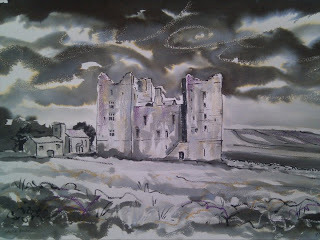
Martin: Bolton Castle, Wensleydale.
This imposing castle was built between 1378 and1399 by Richard le Scrope, 1st Baron Scrope of Bolton.What is quite staggering is the fact that the castle has never been sold and isstill in the ownership of the descendants of the Scrope family. The massiveouter walls of this very well-preserved site dominate the hamlet of CastleBolton that lies at its feet. In its dominating position overlooking thevalley, the castle is now a well-established major tourist attraction in thearea. Painted on location. Pen, brush and ink with wax resist. 22" x 15"
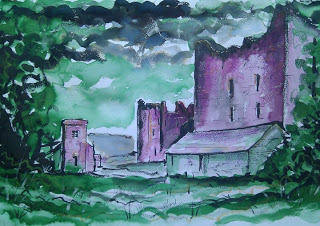 St. Oswald's Chapel at Castle BoltonChristy: The Scrope family were Normans who lived in Herefordshiredecades before the Norman invasion in 1066. Richard's Castle, near Ludlow, was built about1048-1050, and was their administrative center for the Welsh border area. Fourgenerations and about 75-80 years later, my branch of Scropes moved toYorkshire, to Flotmanby Manor south of Scarborough.Another three generations lived at Flotmanby and all were buried at Wensley Church. Finally, there is mention ofBolton, Yorkshire, with Sir William Scrope, 1259-1312.He is the father of (LordHenry) Scropeof Bolton and (SirGeoffrey) Scropeof Masham (14 miles away), both branches of which are my ancestorsbecause their descendants married as second cousins twice removed. Henry Scrope, 1271-1336,married Margaret de Ros(see Helmsley Castle in this article). Their son Richard Scrope was 1stBaron Scrope, Treasurer, Keeper of Great Seal, and Lord Chancellor until 1382, underRichard II. Richard Scrope was the builder of Bolton Castle, and thegrandfather of another RichardScrope, who married MargaretNeville, daughter of MargaretStafford and RalphNeville, 1st earl of Westmorland. Bolton Castle'ssubsequent history may be found at the link below.
St. Oswald's Chapel at Castle BoltonChristy: The Scrope family were Normans who lived in Herefordshiredecades before the Norman invasion in 1066. Richard's Castle, near Ludlow, was built about1048-1050, and was their administrative center for the Welsh border area. Fourgenerations and about 75-80 years later, my branch of Scropes moved toYorkshire, to Flotmanby Manor south of Scarborough.Another three generations lived at Flotmanby and all were buried at Wensley Church. Finally, there is mention ofBolton, Yorkshire, with Sir William Scrope, 1259-1312.He is the father of (LordHenry) Scropeof Bolton and (SirGeoffrey) Scropeof Masham (14 miles away), both branches of which are my ancestorsbecause their descendants married as second cousins twice removed. Henry Scrope, 1271-1336,married Margaret de Ros(see Helmsley Castle in this article). Their son Richard Scrope was 1stBaron Scrope, Treasurer, Keeper of Great Seal, and Lord Chancellor until 1382, underRichard II. Richard Scrope was the builder of Bolton Castle, and thegrandfather of another RichardScrope, who married MargaretNeville, daughter of MargaretStafford and RalphNeville, 1st earl of Westmorland. Bolton Castle'ssubsequent history may be found at the link below.More info: http://www.boltoncastle.co.uk/metadot/index.pl
HelmsleyCastle, north Yorkshire
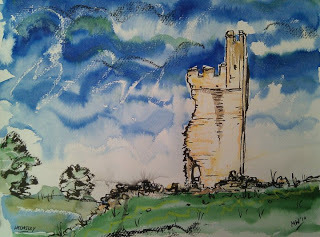 Martin: Helmsley Castle from North Gate This medieval castle ruin islocated in the market town of Helmsley, North Yorkshire.Originally it was built in wood around 1120. Now in the care of English Heritage.Painted on the spot. Mixed media. 15"x 11"
Martin: Helmsley Castle from North Gate This medieval castle ruin islocated in the market town of Helmsley, North Yorkshire.Originally it was built in wood around 1120. Now in the care of English Heritage.Painted on the spot. Mixed media. 15"x 11" Christy: Helmsley Castle was begun byWalter d'Espec ("the Woodpecker"), a prominent military and judicial figure inthe reign of Henry I. Walter also founded Kirkham Priory and Rievaulx Abbey. Becausehe was childless, upon his death Helmsley passed to his sister Adeline d'Espec and herhusband's hands, the powerful de Ros (Roos) family, who were barons, the progenitors ofScottish and English royalty, ancestors of the Neville family, and wereTemplars and Crusaders. The castle was improved by the de Ros's succeedinggenerations, and was "slighted" (destroyed) by Parliamentary forces in England's CivilWar.
More info: http://en.wikipedia.org/wiki/Helmsley_Castle
Peveril Castle,Castleton, Derbyshire
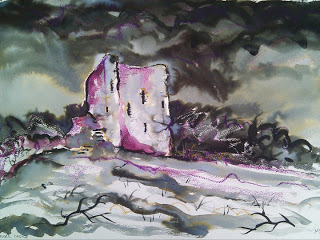 Martin: Peveril Castle, Derbyshire.
Martin: Peveril Castle, Derbyshire.The imposing ruins of PeverilCastle overlook the village of Castletonin the Derbyshire Peak District. The keep was built by Henry II in 1176, making the castle one ofthe earliest Norman fortresses in England. Now in the care of EnglishHeritage. Mixed media. 15" x 22"
Christy: The earliest-known ancestor of the Peverel name, William Peverel the Elder,born 1043 in York,came from a long line of Welsh people on his father's side, and a Saxon mother.His patrimony seems to have survived the Norman Conquest, which is quiteunusual for Welsh or Saxon landowners, so one might suppose that he fought onthe Norman side at Hastings and thereafter. His grandson WilliamPeverel the Younger committed the poisoning murder of Ranulph de Gernon, earl of Chester and hadhis lands seized by Henry II; and his granddaughter Margaret Peverel b. 1114, married into the de Ferrers family, earlsof Derby, andher tomb effigy still exists at the gatehouse chapel for Merevale Abbey inWarwickshire. Margaret Peverel Ferrers' son William Ferrers, 3rd earl of Derby, rebelled against Henry II and in 1155 losthis title and claim to the lands of Peverel. Two hundred years later, thatWilliam's eighth-generation descendant was Mary de Ferrers. Ralph Neville, secondearl of Westmorland (son of RalphNeville the first earl and Margaret Stafford, married Mary de Ferrers, granddaughter of Katherine Swynford and John of Gaunt, anddaughter of Joan Beaufortand Robert de Ferrers.It's all quite complicated, but I had to work in the Ralph Neville name to pumpmy blog hits—aren't I shameless!
More info: http://en.wikipedia.org/wiki/Peveril_Castle
Middleham Castle,Wensleydale, Yorkshire
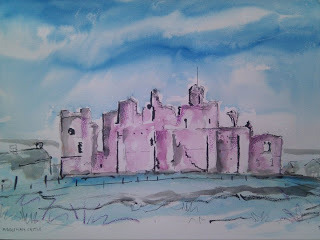 Martin: Middleham Castle.Middleham Castle inWensleydale, North Yorkshire, was built in1190 and was once the home of Richard III. The extensive site includes amassive Norman keep surrounded by a curtain wall. The ruins are now in the careof English Heritage. Painted on location.Pen, brush and ink with wax resist. 22" x 15"
Martin: Middleham Castle.Middleham Castle inWensleydale, North Yorkshire, was built in1190 and was once the home of Richard III. The extensive site includes amassive Norman keep surrounded by a curtain wall. The ruins are now in the careof English Heritage. Painted on location.Pen, brush and ink with wax resist. 22" x 15" Christy: RobertFitzralph 3rd Lordof Middleham and Spennithorne, 1110-1185, has a long line of ancestors back to the ninth century and beyond. Genealogy sites list his death as 1185, butevery site also says that Robert Fitzralph built the castle of Middleham"commencing in 1190"—apparently fiveyears after his death. (This looks like a job for the History Police,unless you attribute the work to his wife, Helewisa de Glanville and their young son.) Robert also founded Beauchief Abbey in Sheffield—luckily, though, while he was still alive! Hisand his son's (RanulfFitzrobert) tomb effigies were dug from the rubble of nearby CoverhamAbbey and their photo is contained in the header of this blog. Robert Fitzralphis the great-great grandfather of Ralph Neville, 1st earl Westmorland (Ralph Neville again?? He gets the most hitson this site!).
More info: http://www.middlehamonline.com/Middleham%20Castle.htmMore info: http://en.wikipedia.org/wiki/Middleham_Castle
Clifford's Tower, York Castle, Yorkshire
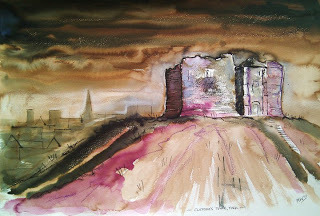 Martin: Clifford'sTower, York.
Martin: Clifford'sTower, York.Clifford's Tower is actually the remains of the13th century keep of York Castle, sat on top of amotte, or defensible mound. The keep is of unusual design, being quatrefoil inplan (four overlapping circles) and is the only example of this kind in England. Todayit is a well-known and instantly-recognizable tourist attraction, oftenphotographed in the spring with the motte ablaze with daffodils and the Towerset against a clear blue sky. I have portrayed the Tower rather differently,perhaps hinting at its more brutal past: the name 'Clifford's Tower' comes fromRoger de Clifford who was hanged there in 1322. Clifford's Tower is now in the care of EnglishHeritage. Pen, ink, wax resist and chalk.15" x 22"
Christy: Roger, second Lord Clifford, who was hanged in 1322 byHugh Despenser the Younger, was my "uncle," so all Roger's ancestors are alsomine. His sister, Idoine de Clifford,was born c 1300, married Henryde Percy, 2nd Lord of Alnwick, 1st Earl Northumberland, and died 24 Aug1365. Clifford's Tower is the keep for York Castle,which was a royal fortress established by William I, and rebuilt in stone by Henry III.
More info: http://www.cliffordstower.com/ More info: http://en.wikipedia.org/wiki/York_Castle
DolwyddelanCastle, north Wales
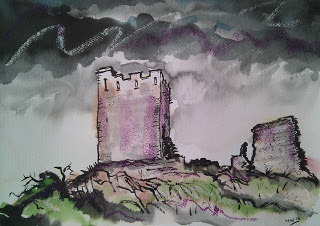 Martin: Dolwyddelan Castlenear Betws-y-coed. This is s very striking ruincommanding a wonderful position on top of a ridge with stunning panoramicviews. Dolwyddelan stands alone in a country of castles as it was built about1210 by the Welsh princes, not by English or Norman forces. Painted on the spotin mixed media.
Martin: Dolwyddelan Castlenear Betws-y-coed. This is s very striking ruincommanding a wonderful position on top of a ridge with stunning panoramicviews. Dolwyddelan stands alone in a country of castles as it was built about1210 by the Welsh princes, not by English or Norman forces. Painted on the spotin mixed media.Christy: Dolwyddelan Castlewas a native Welsh castle located near Conwy. It was built between 1210 and1240 by Llywelyn the Great ap Iorweth, Prince ofGwynedd and North Wales. The Welsh castlefunctioned as a fortress. On January 18, 1283, it was captured by Edward I of England ("Longshanks") inhis conquest of Wales.The castle was then modified and strengthened for occupation by an Englishgarrison.
More info: http://www.castlewales.com/dolw.html More info: http://en.wikipedia.org/wiki/Dolwyddelan_Castle
Chirk Castle, Wales
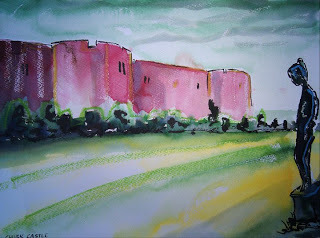 Martin: Chirk Castle.
Martin: Chirk Castle.Completed in 1310, Chirk Castleis the last Welsh castle from the reign of Edward I still lived in today. Builtby Roger Mortimer, Justice of North Wales for Edward I, the castle commands aprime position overlooking the Ceiriog valley. The castle was sold for 5,000pounds to Sir Thomas Myddelton in 1595. Sir Thomas's descendants continue tolive in part of the castle today, although the National Trust now care for theproperty. Mixed media on 230gsm paper.14.5" x 10.5"
Christy: Some reports say that Roger Mortimer (one of many "RogerMortimer" fathers, sons, and cousins) built the castle of Chirkon land he had been granted in 1282. That Roger died during lifetime imprisonment inthe Tower of London in 1326, and his grandson John Mortimer signed over hisrights to Chirk Castle to his cousin Roger Mortimer 2nd earl ofMarch (brother of my ancestor Isabella Mortimer Fitzalan), in 1359. Another version has it that Roger Mortimer 1stEarl of March (rebel against Edward II and one of the regents to Edward III before Roger's execution in1330) built the castle in 1295 as part of the Edwardian chain of Welsh castles.
More info: http://www.castlewales.com/chirk.htmlMore info: http://en.wikipedia.org/wiki/Chirk_Castle
*****************Thank you again, Martin, for beingso agreeable about sharing your fine art. Readers, if you enjoy his paintings,please observe international copyright laws and contact him for permission toreproduce the images—or perhaps to enquire about purchasing a print, orcommissioning a canvas depicting your ancestors' landscapes or edifices.Remember: images ©Martin Williamson 2011. Thisis the link tohis contact information. Martin welcomes friends to his Facebook pages, and you'll find that link in his website.
I've selected a few of Martin's churches to feature at another time, which connect with ancestors or their burials. Are you interested? What do you think of this blog post? Leave a comment below!
Published on August 03, 2011 13:49
July 30, 2011
Celtic Britain travel journal part iv
BritainTRAVEL JOURNAL--part 4 (England tour extension)
Monday, July 2, 2001 , Kensington, London
Good thing I don'tgamble. I didn't find any tombs or stones. Please! They must have thousands ofgraves around there, at York Minster. Where were they moved? Are they coveredby a plaza?
Well, let's do itchronologically. As a group, we hiked through the medieval streets to the Yorvik Viking Museum. It was probablyclose to two miles, some of it uphill. I fell behind, and stopped for a publicrestroom, so I was separated from the group, very early on. The museum was amulti-media presentation, a ride through a real archaeology dig, populated byanimatronic humans and animals. It was dated ca 975 AD. The fossils and findswere interesting.
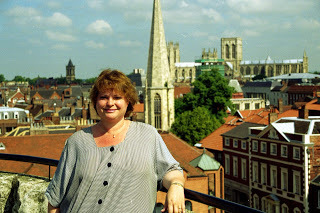 I'd heard (well,overheard) about a York Castle museum in the giftshop, so I inquired. It was three blocks more, which I walked, of course."It's only a five-minute walk," was the response everywhere I went.When the castle (Clifford's Tower) came in sight, I totally blew off the museumidea! I climbed steep concrete stairs up the motte, the keep's bank, paid a £2admission, and was in the bailey of my ancestors' castle. Eventually, I climbedthe steep and uneven spiral steps up a tower, to get to the top battlements. Ihad a stranger take my picture up there on the battlements, with the Minster inthe background. He didn't seem to know English, but he could press the properbutton on the camera! The man was tall and Nordic looking. The castle was builtby Henry III and named Clifford's Tower (I have Cliffords, Marcher lords, backthere, too). By the time I got down all those steps, there was no way I couldwalk the 1.5+ miles back to York Minster, where everyone else was, so I calleda taxi from a nearby hotel desk.
I'd heard (well,overheard) about a York Castle museum in the giftshop, so I inquired. It was three blocks more, which I walked, of course."It's only a five-minute walk," was the response everywhere I went.When the castle (Clifford's Tower) came in sight, I totally blew off the museumidea! I climbed steep concrete stairs up the motte, the keep's bank, paid a £2admission, and was in the bailey of my ancestors' castle. Eventually, I climbedthe steep and uneven spiral steps up a tower, to get to the top battlements. Ihad a stranger take my picture up there on the battlements, with the Minster inthe background. He didn't seem to know English, but he could press the properbutton on the camera! The man was tall and Nordic looking. The castle was builtby Henry III and named Clifford's Tower (I have Cliffords, Marcher lords, backthere, too). By the time I got down all those steps, there was no way I couldwalk the 1.5+ miles back to York Minster, where everyone else was, so I calleda taxi from a nearby hotel desk. I got into a group tourafter photographing the carved stone statues of my ancestors from William I toEdward III. I visited the crypt in hopes of finding tombs, but it was actuallyRoman remains and the Norman foundations of the existing gothic cathedral. Iwalked the half mile back to the hotel and waiting bus.
We drove for five hoursto Central London, with me in the jumpseattaking pictures, again, and here I am!
A tour guide met us androde along for 90 minutes while pointing out sites I've read about for years.The guide reminded me, in a subtle way, of a person I loved very much, for along time.
Tuesday, July 3, 2001 , Kensington
It's 90 degrees in thishotel room, with no fan. The window opens eight inches at the bottom. Nobreeze. This sucks. Actually, it was hot all day. This was the day our tourgroup split. Some went walking and shopping; others took a city sightseeingtour. All who were flying back today met at 1 p.m. to shuttle to Heathrow. ButI wouldn't know about that.
I was on the sightseeingdouble-decker bus. Included was a 50-minute cruise on the Thames.That was a cool and breezy oasis in the warm day. I had a fish-n-salad(substituted for chips) at an outdoor restaurant in a small park on theEmbankment, and listened to a live jazz band and watched pigeons. The pigeons knowwhen diners are finishing up, and start flying in closer, like short, fatvultures.
I shopped for an hour inthe very hot Picadilly Circus area, and at Victoria Station. I got back to thetour bus and saw another loop or two of London.I was making my way back to Kensington, where my bags were stowed at theHilton, but the traffic out to the West Endwas gridlocked. Took two hours to crawl from Baker Street station out to Holland Park. I was the last person on the bus,and I told them I'd walk the last two blocks, which thrilled them. Would havebeen another 30 minutes in the bus! Then I waited a further 90 minutes, 'til8:30 p.m., to call a taxi, so I wouldn't have to pay to sit in traffic on thetransfer to my hotel reservation in South Kensington.I was hot and gritty from the bus rides, my feet are sore and swollen. FinallyI got here, to the Kensington Edwardian, and had to schlep my own bags to thetop floor, via the lift. It's now 11 p.m. and still 90 degrees in here. I'vehad a cold shower, and begged for a fan, but it's unavailable. I've got a wethand towel over my shoulders.
Wednesday, July 4 , 2001, Kensington
Right. My patrioticAmerican-versus-British revolutionary act, this Independence Day, was to get myhotel room changed. Told the manageress, very politely and quietly, that a 90degree room and bad mattress left me in agony, that my attempt at makeup hadmelted off, that I needed better accommodation and a fan, and that theirtwo lifts were not working, and I wasn't willing to climb up five floors in anairless stairwell to boot. They moved me to a first floor (actually mezzanine)corner room with cross ventilation, and brought a fan. It's still not exactlycool, but 15 degrees off, plus moving air helps a lot. I was finally on my wayat 10:30.
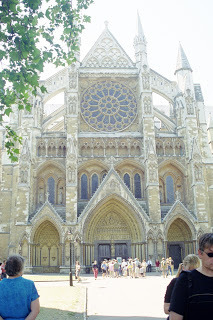 I have to walk about halfa mile plus a block, to get to the Tube at Gloucester Road Station. So I'm hotand footsore before I'm started. I got off the airless train at WestminsterStation, and came up right at the Thames River, with Boudicca'smonument above me. Big Ben was ringing Westminster Chimes (natch) at 11, as Iwalked to the Abbey church.
I have to walk about halfa mile plus a block, to get to the Tube at Gloucester Road Station. So I'm hotand footsore before I'm started. I got off the airless train at WestminsterStation, and came up right at the Thames River, with Boudicca'smonument above me. Big Ben was ringing Westminster Chimes (natch) at 11, as Iwalked to the Abbey church. Tons of people had thesame idea as I did, and Westminster Abbey was very crowded. I rented the audioguide and made my way through all the side chapels. Thousands of monuments,graves, wall plaques, floor stones, etc., honoring the dead. I was touched byone eighteenth century monument to a young woman. It extolled her Christianvirtues in beautiful prose, and actually made me wish to have known her. Nowthat's good writing! Eventually, I got around to the back sides of theancestors' graves around the chancel, and close to the Edward the Confessorshrine. I caught glimpses of the sides of the effigies, but the place touristscould stand was much lower than even the bottom of the sarcophagi. Also astrict policy on photos (as in, NONE), but no books or postcard photos have pixof what I want: overhead shots of the burial effigies of my forebears. Thechancel was roped off, so no access to the sarcophagi that way unless I was anon-staff Anglican priest.
I stopped several timesto rest my excruciatingly painful feet. At 12:30, I took Anglican Communion inthe far west part of the nave. The prayers and parts of the Protestant"mass" were really beautiful. I visited the undercroft and museum(cool: I'd read about the undercroft treasury/exchequer in Sharon Kay Penmanbooks), the bookshop, and the evensong service. Only no song! Just prayers.They only sing every other Wednesday, and I was there a week too early or aweek too late.
I stopped at a restaurantfor tomato basil soup, and bought grapes and a bottle of milk in the GloucesterRd Tube station, and walked by the McDonalds and Texas Lone Star Grill, BurgerKing and Starbucks.
Hotel room is much coolerthan starving-artist garret of last night. Wrote postcards this evening.
I keep wondering, Could Ibe more tired? And then I answer myself, Yes, I'm more tired and in more painthan the last time I asked myself that question.
Thursday, July 5, 2001, Kensington
Oh, my burning and achingankle stubs. Have worn off original, God-given feet issued at birth. It's sohot and humid, too! OK, enough groaning.
Walked through hot, damphaze to Tube station, rode Picadilly line to Great Russell Square. Then it was atleast three-quarters of a mile to the British Museum.(Another "five-minute walk.") Must say, however, that anyone I askfor directions, including Tube personnel, are very helpful and friendly,despite that Five-Minute Walk they keep telling me.
Anyway, at the British Museum, I walked up the front, outsidestairs. Then after buying my special exhibit ticket, up two more flights to theCleopatra show. This is six stories so far, if you're keeping track, not evencounting the many flights in the Tube stations. After seeing Cleo-baby, JuliusCaesar, Octavian Augustus, Marc Antony, and lots of naked Egyptians, I had toleave the blessedly air-conditioned exhibit. Probably the only a/c in the British Isles.
I had to go down fourstories to get to the other halls, and then up four stories plus a long gallerywalk, to the Celtic and Roman Britain displays. I was following directions inthe Visitor Guide. It was hot and airless in the display rooms, and no benchesor chairs to sit on, either. A security guard let me have his chair and fan forabout 20 minutes until my soaking wet hair dried off, and my body temperaturecame back to normal. Have I mentioned that nothing in Britain is air conditioned? (Oh, Ihave. Sorry.) My makeup had of course melted before I got halfway to the Tube,and my hair was dripping with perspiration.
But for all my aches andpains and fever, it was worth the effort. I saw so many artifacts I'd seen inhistory or art books. In fact, every time I saw something amazing and beautifulin a picture, the photo credit always said, "The British Museum." Sohere I was, seeing Lindow (peat bog) Man, Sutton Hoo mask, Rosetta Stone,Easter Island Head guy, Elgin marbles, Cleopatra, Ramses II, the Ram in theThicket, mummified people and cats, Assyrian winged beasts, etc. So impressive.
I had lunch in the nicerestaurant: cran-blueberry sparkling mineral water on ice, and strawberrieswith clotted cream. Took Tylenol several times to little effect. After begginga warden, I was shown the well-hidden and discreet lifts! They'd been holdingout on me.
At 5 p.m., I changed intomy gold metallic top and black jacket I'd been carrying in my bag, and walked afew painful blocks to a bus stop. Caught one to the Strand,and then tanked up on bottled water and skim milk from a market, then a mochafrappucino at Starbucks. Man, I was dehydrated after all the heat,perspiration, walking, stair climbing, etc. Finally, though, I was feelingbetter (probably the caffeine and sugar). I walked around the corner to the Lyceum Theatre and picked up myticket to the show, Lion King. (Up stairs, down stairs, up stairs once more.) Ishared a box in the baroque theater with a Kentucky university student. When the showstarted, an actor in full costume came into our box, and I involuntarilywhispered, "All right!" So he bent down and kissed me on the lips! Aspotlight was shown on him, and he started singing across the theater to hiscounterpart in the opposite box. It was over in a minute, and the show startedon the stage. The choreography of the dancers, dancer/puppeteers, and peoplewho played scenery (trees and grass) was very creative and so beautiful.Genius, really, to conceive of it.
After the three-hourshow, I was told to walk for "five minutes" to Charing Cross Stationfor the Tube. Wrong station, but I did snap a photo of Eleanor of Castile'sEleanor Cross, recreated after Civil War dismantling. (Yes, Eleanor's another ancestor.) After another Five Minute Walk (sure,sure), I got to the Embankment or Strand Station, whatever. There had been arain shower during the show, but now it was cleared off, cooler, and there werepuddles. Took the Tube back toward the hotel, and walked here again. I can'twrite this without dozing off again and again.
Friday, July 6, 2001 , Kensington
I'm actually writingFriday's entry on Saturday morning, but DEAL WITH IT. I'll write as if it'sstill Friday:
By 8:45 a.m., I set outfor the Tube station, took the subway as far as it went, at Ealing Broadway,then bought a £3.40 round-trip train ticket via Sloughto Windsor/Eton station. Walked up the slight hill to the castle ticket office,and was there at 10:40. Then I hiked up a steeper hill, around the castle keep,then down the hill to the castle's lower ward to watch the changing of theguard at 11. No short cuts in England.The fife and drum band was good, but there sure was a lot of fuss andceremonial slapping of guns and stomping! Took half an hour, too. Guy stuff. Ifthey were women, they'd do it faster, more efficiently, and there'd be moremusic and no stomping.
Scoped out the St. George's Chapel, wheresome of the English royalty were buried. None of mine, however. One of theexterior gargoyles or grotesques was a cow. Go figure.
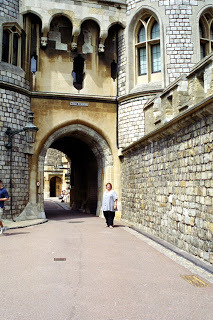 Much of Windsor Castlewas built by successive generations of my ancestors, so I was eager to see it.We weren't allowed in the oldest part, the round tower, and the privateapartments, of course. Still, it was gratifying to see the Norman Gate, thestonework of the walls, the hilltop view of Berkshire, and — kind of bizarre —747s taking off from Heathrow, over the Norman round tower. What would Henry Ior any of them have thought of UFOs in their view of the sky? Demons? Angels?
Much of Windsor Castlewas built by successive generations of my ancestors, so I was eager to see it.We weren't allowed in the oldest part, the round tower, and the privateapartments, of course. Still, it was gratifying to see the Norman Gate, thestonework of the walls, the hilltop view of Berkshire, and — kind of bizarre —747s taking off from Heathrow, over the Norman round tower. What would Henry Ior any of them have thought of UFOs in their view of the sky? Demons? Angels? Then I climbed back upthe hill to the entrance to the State Apartments. I climbed lots of shallowsteps. The first couple of large chambers were very crowded with tourists. Therooms were lined with lit glass cases of 200-300 year-old china. One that Iliked very much was a set of wild flowers, a different flower on each piece. My20 year-old flower pattern mixture back home seems like such good tastenow!
The next rooms, upanother flight, were martial in nature. Lots of spears and armor and swords.Couple of spare crowns, too, from Thailand(King Mongkut of Anna and the King presented gold crown looking likeThai temple to Queen Victoria), and one from Ethiopia.There were notations that certain items were "taken" at the Battle ofWherever. (In the name of the British Empire,I demand that you hand over your ancestral lands, keys to the treasure, yourgovernment, etc., at once.) There were jeweled swords and daggers, covered inemeralds, rubies, maybe diamonds.
Then we continued throughdining and reception rooms, bed chambers and "closets," etc. Iexpected to see great art, and I really did. The three faces of Charles I (so asculptor in Italy had an almost 3D model), the Holbein paintings of Henry VIIIand Elizabeth I, Rembrandt self-portrait, fresco ceilings, huge tapestries,sculptured busts, silver furniture, gold-leaf woodwork, etc. The carpets wewalked on were tourist ones, and the lanes were roped. The carpets the Queenand guests walk on are huge room-size Persian ones. (I think BernardBrandstater's carpet, maybe one-eighth the size, but still really large, took sevenyears to weave and knot.)
Finally, one of the laststate rooms was the Knights of the Garter guard room. I was limping and hurtingbadly despite the Tylenol at 11:30 a.m., so I asked a guard if there was abench or chair to sit on for a few minutes, "obviously not thethrone," I laughed. He brought a red side chair for me and I massaged myfoot through the sandal.
When I did make it to thethrone, in blue velvet over polished dark carved wood, the appliqued embroiderysaid "E III R 1350." Hello, grandfather! Edward III, whose 6'8"steel sword I'd seen in St. George'sChapel earlier in the day, founded the Knights of the Garter. No pictures wereallowed, but I had my camera around my neck. I put it on wide angle, and fromtummy-level, I aimed in the general direction and snapped a coupleavailable-light photos when the guards were far away.
Well, there was a lotmore walking and hiking. I went to an Internet café for half an hour, hopingfor a cold drink, but the cooler had just been stocked with room-temperaturepop. Forget it! Checked my e-mail, though. Got directions for the inevitableFive Minute Walk down to the Thames River for a £4, 35-minutecruise. That was nice: although we didn't see anything important, it was goodto sit and enjoy the cool river breeze, and watch swans and blue dragonflies. Apiece of fried fish (no chips) and a 15-minute walk of pain brought meback up the hill to the train station. Two trains and two subways later, I wasback here at the hotel. That half-mile walk hurts more every time!
Saturday, July 7,2001 , overArctic Circle, maybe
I'm miserable. Not asmiserable as the screaming toddler only 8 feet away. Not as comfortable as theidiot teenager who sits in front of me, reclining his seat into my space. I'mso sick of being pressed on every side and bumped on the aisle. My knees hurt,my head hurts. Had an argument with the bloody teen's mother, who said if Ididn't like it I could call the flight attendant. So I did. She asked him tomove up and he did, microscopically. We boarded the plane before 4 p.m., for4:35 takeoff, but didn't take off 'til nearly 6:45. When my seatmate, aDanish-born Egyptian, came back from his walk, I got up to let him in and OOPS—jolted the teen's seat back.
You'd never know it by mymood now, but I actually had a pleasant morning. Woke around 6, and finishedorganizing my bags. Then walked to the Tube and took two different subways pluswalked about 2 blocks, to get to St. Paul'sCathedral, in the City of London.Got there at 8:07; unfortunately, Communion mass started at 8:00. A deaconshowed me to a seat in a chapel to the rear left of the nave. There were onlyabout six of us there, but the priest and a robed helper read the prayers fromthe missal, leading up to Communion. We took the bread (papery wafers) and asip of wine from the chalice, kneeling at the rail. Ow. Then I stayed andprayed silently in the large nave, under the famous and massive dome, for about30 minutes.
About 9 a.m., they letthe tourists in, and I tailed along on a guided tour. Aside from the goldceiling mosaics, the fact that Charles and Diana married there 20 years agothis month, the beautiful architecture, etc., I guess the thing that wasimportant to remember was: During the WWII London Blitz, men risked their livesto save God's house. I'd rationalize, myself, that God lives in my temple, me,not one made by human hands. But these men saw beyond themselves, to thegreater community and the symbol of hope that St. Paul's was to them. They'd go up the roofduring bombing raids, and if something fell and didn't explode, they'd pick itup and heave it away. I think just the east chancel was destroyed, and ofcourse was rebuilt after the war. That was my Saturday morning in London. It was bothinspiring and instructive.
After a couple photos onthe plaza outside St. Paul's,I walked and Tubed and walked again back to my hotel. Checked out. Waited forthe Heathrow transfer van. When the driver got there, he pulled down a seat forme, and its metal bar fell on my right toes. "OW!" I yelledinvoluntarily at the other 14 passengers, then apologized for my outburst. Butmy face must have shown the pain, because a British lady said, "You'reputting a brave face on it, dear." If by brave, you mean strained andwhite.
I walked a lot in theairport terminal, was not impressed by duty-free prices, and then got on thisexcruciatingly crowded Air New Zealand jumbojet. Doesn't feel at all jumbo. In fact, they should take out a row of seats atthe back of every section, and install treadmills and exercise bikes, and signpeople up for 5 or 10 minutes each. It is unconscionable that they cram 450people in here elbow to elbow, with nowhere to walk except to the tiny toiletsand back. We'll be on this plane for 13 hours. They did call for a physicianover the speakers, but I don't know what for. Probably for the nervousbreakdown of a passenger crammed between a sleeping seatmate and a beveragecart. Oh! That was me! Sorry.
I've read countless pagesof the sequel to Bridget Jones's Diary (very funny), and am worried thatI'll run out of book before I run out of plane. I mean, it's been seven hoursalready, and we're only over the Labrador Sea.Not even Canadayet.
Somewhere over Wyoming, 3 a.m. Londontime, 7 p.m. LA time.
Managed to doze betweenscreaming baby bouts and sore knee. Foot swollen, not recognizable as humanappendage. If this flight was on time, we'd be flying over the Colorado River right now. My seatmate was leaning on myshoulder to sleep, and I was hanging into the aisle with a back ache. The creware serving hot sandwiches that smell of ham and spinach quiche. I guess theydon't know if it's dinner or breakfast, either. Combined with slightturbulence, makes me queasy. Finished the book two hours ago. Now what do I do?It's the same in-flight movie they showed three weeks ago on my way to London.
St. George, Utah, 8:39 p.m. LA time — Almost there. So exhausted. Beenawake now, 24 hours. The sun's finally gone down. This day was almost 31 hours.
LAX airportinternational terminal, arrivals, 11 p.m. — My "friend" Mr. P was supposedto be here about 9:00 to pick me up. We did get in 90 minutes late, but I'dbuilt that into the pickup time. I was out at the curb, and no Mr. P. I startedtrying to call by 10:25, but no luck, as I don't have the correct number forhim and the phone is in his girlfriend's name, and I'm pretty much brain deadso can't remember her surname. Finally called collect to Richard Tinker in Yucaipa, and he's coming to rescue me. Probably be hereafter midnight.
Sunday, July 8,2001, Redlands, CA
10:15 a.m. So good to behome. Richard and Colleen dropped me and luggage at about 1:40 this morning. Igreeted the cats and was in bed by 2:20. (Had been awake more than 28 hours.)Cats plastered themselves to me. Major purring.
Back and front yards havehuge weeds. The peaches are nearly ripe, and have more tomatoes and squash.Today I do laundry (first time in 3 weeks), get groceries, and check mail.Mundane ending for great trip, but I can live with it.
Saturday, July 14,2001, Redlands
Worked every day thisweek, and when I'd get home in evening, all I could manage was to feed cats,have a bowl of soup, and a little bit of pasting photos into album, but had tosleep by 9 p.m.. That is so not me. Afraid I spaced the pastor's sermon as I could barely stay awake. At Cross Cultureservice, we had many technical problems owing to absence of several key teammembers. While they worked on solutions, I took a mic and told of my Lindisfarne experience, when God spoke to me. They"amen-ed" heartily. This afternoon I slept three hours. I think thisis the end of the jet lag, though. My body is back on Pacific Time.
Been gluing pix intoscrapbook. At it for a week, but have barely made a dent.
Random observationsSheep and cattle and horses in Britain are happy, contentcritters. Ours must be stressed to stand in muck in feedlots. Here, they grazeand wander and ruminate, and nap actually stretched out in the sun.
Music: most shops have music playing.Really annoying techno-pop, mostly. In Starbucks on the Strand in London, I heard (the firstand only time) British superstar Sting. Found a couple CDs of his in PicadillyCircus that aren't available in US. Heard jazz in the park on the day I went onthe London City Tour and Thames cruise.
Clothes: would pay any money for alaundromat. Nothing. Michelle and I went through half a bottle of Febrezefabric deodorant spray! People here dress the same as in the US. No special trend that I cansee. Love to see men in Shetland sweaters!
Tans: the Brits are known for theirpasty white complexions. Yet I've got a tan since I came here. Every park youpass, there are many people sitting on beach towels or blankets, just sittingand doing nothing. No urge to be productive during lunch or break. Just gooutside and SIT.
Food smells: Dublinand Edinburghsmelled divine. Until you realize that the smell is malting barley, destinedfor whiskey! Oh, man, everywhere I went, the barley smell was there. Icraved a good barley stew, but never found one. I think I also enjoyed thesmells of bar food in Dublin.If you could get past the vile cigarette smoke, the fast-food or bar pickupstuff smelled wonderful. But oh, the barley — it's enough to drive one todrink!
The telly: Hey, no problem with saying theF-word or showing uncut R-rated movies on regular broadcast TV. The prime-timehas soaps, game shows, etc. They have BBC 1 and 2 morning news, and also a GoodMorning news/chat thing. One station was sports-only. And it was Wimbledon time. I watched a two-part detective show thatI suppose will turn up on PBS Mystery, soon. Looked in vain for a "Britishcomedy," but maybe they're not on in the season or time of evening that Iwatched. Hardly any commercials, and never during a show, but they were prettyfunny. The hotels only have five or six channels. It was funny to see 500year-old stone buildings with 18-inch satellite dishes mounted on the sides.
Exercise: I deserve a huge medal (ala thosewrestling belt buckles) for all my walking and stair climbing. When I ask fordirections, the people say, "Oh, that's just a Five Minute Walk."Maybe for them! But I was fooled every time. What a sucker I am. I trudgedmiles, every day. Stairs everywhere, always. No escalators, either.
I'm proud that I've doneso much, though. I kept going even when the young and fit 20-somethings weredragging. When the group was climbing up to Durham Cathedral, although I wastired, I wasn't out of breath. When I asked to stop for a moment to rest, everyoneelse stopped, too — not out of pity for me, but because they were also beat!With all the exercise, one needs hydration. I haven't seen one drinkingfountain or water dispenser anywhere, but plenty of people haul sports bottlesaround. They seem to prefer mineral water to "still" spring water.However, it finally occurred to me that spring water and mineral water weresynonymous. The drink coolers are set at about 55 degrees, I think, becausestuff is just barely cool, never cold. Never ice!
Restaurants: Do these people ever eat at home,or cook? Every block has many restaurants and pubs and deli-type shops. Thesupermarkets aren't really very super. Everyone must shop a little each day andcarry it on the Tube. No station wagons or mini-vans backed up to a Costcoloading dock! Even the lower-priced restaurants use tablecloths and clothnapkins, and serve the meal in leisurely courses. Wish I could have mytea/coffee with my meal instead of after. When I ask, they seemsurprised! The servers don't come around very often, and that's a plus. Asidefrom "the frozen kind" of fried fish, which was perfect, the otherfish-minus-chips I've bought had skin on, which was gross! So I ate the toplayer, but threw away the skin and attached batter. I also bought sandwiches ora pasty, and soups, and once just ordered strawberries with clotted cream. I'malways on the run (almost literally) so I don't want anything to slow me down.What kind of foods on the menu? (Not saying I ate these, just that they wereavailable.) Pork (sausage, bacon, ham), seafood (salmon, shrimp, tuna), beefand lamb practically non-existent because of hoof-and-mouth disease outbreak,eggs (fried, poached, scrambled), various cheeses, beverages (hot tea andcoffee after meal, wines, hardly ever water and never glasses of milk or icedtea, cola and other sodas), breads (baking-powder biscuits, croissants, scones,sliced white and brown and rye bread, pita), breakfast cereals (Special K,Cornflakes, muesli that looked like lawnmower outflow, oatmeal), vegetables(potatoes, carrots, zucchini, etc.), fruits (melon, strawberries, blueberries,kiwi, same as at home), dessert (almond or Bakewell tart, strawberry/ rhubarbpie, strawberries and unsweetened cream, ice cream, trifle, etc.). Thevegetarian offerings weren't very good. No meat analogs. Either eat strangevegetable medleys in pasta or buried under crumbs, or go for the cheese/eggthing.
Flowers: The foxglove and lobelia and irisflags and many other flowers are blooming wild, everywhere. In the cities, Isee buckets and buckets of cello-wrapped arrangements. They'd be $15-20arrangements in the US.Lots of people buy flowers, men and women, and carry them with the shopping.Home, presumably.
Ancestral ties: Early on, I sensed that my tourmates wouldn't share my fascination with the ancient and medieval history of Great Britain,nor in such a personal way. How many times could I crow, "My ancestor,King So and So, built this castle or commissioned this cathedral." (But hedid!) Well, it slipped out a few times, but I decided to keep most of it tomyself. There were many, many times when I COULD have said something about theancestors! The docents at Windsor/St. George's Chapel, Durham Cathedral, etc.,though, were pretty excited to talk about (really, really) old times with me.They were interested that a descendent of the Angevins and Plantagenets wouldbe living in California.I suppose I have lots of distant cousins all over the US, andprobably many of the Commonwealth countries, but one doesn't really think ofit. You think of the current Royal Family as being the only realdescendants that count! Dorothy and Robert knew of ancestral ties in Ireland, andJohn and Carl are of Welsh descent, so I wasn't the only one feeling the senseof deep roots.
Alone in a crowd: Even though I was part of a22-person group, somehow I managed to be alone in most places — alone tomeditate, pray in the holy places, appreciate the quiet or the memory ofsomeone's loved one encapsulated on a tombstone. Maybe this was anti-social,but while others were figuring out where to go and what to do and how to do ittogether, I just took off and got started! While others were getting ready toexplore Bath, Iwas on the tour bus, then exploring the abbey church during organ rehearsal,and then dipping fingers in the hot pool. At Edinburghon Saturday afternoon, I did my own exploring, and at Iona,while the group walked to the abbey, I was hiring a bike. At York I was entirely alone. How slippery ofme. But it's hard to pray, or soak in beauty when you're surrounded by others.I suppose it could be considered selfish, but I doubt anyone paid their bucksto be entertained by me, anyway!
Published on July 30, 2011 13:47
Celtic Britain travel journal part III
Celtic BritainTRAVEL JOURNAL--part 3 (Scotland, Northumberland, Durham, York)
Wednesday, June 28,2001 , latenight, Edinburgh, Scotland!!!
We drove out of the Irishferryboat and onto Scottish soil, port of Stranmaer, at around 7p.m. We drove about three hours, and passed through Ayrshire ("Haste yeback," said the road signs at the village borders), Strathclyde, Midlothian, and whatever we're in now. Irregular fieldsof hay and barley, and the odd potato farm. Cattle, a palomino horse or two,sheep, a donkey. Views of the sea off to our left, with a sugarloaf mountainisland out there. All beautiful, the whole way. The buildings don't seem as oldas the Irish ones, though.
Since it's summer timeand we're far north latitude, the sun goes down really late, after 10 p.m. Wegot to Edinburghwhile there was still fairly bright twilight, after 10.
Oh, man, you can see the Edinburgh Castle across the street from our hotelon Princes Street.The tour mates were squealing with delight at our posh surroundings andaddress. Although our hotel faces the Royal Mile and the Walter Scott Memorial, etc.,our room faces an alley and fire escape stairs!
After getting our bagsinto the room, six of us went out for a walk, and bought super-cheap paperbackbooks at a nearby store which closed at midnight. Back at the hotel aftermidnight, I did laundry in the bathtub, and hung it on the heated towel bars todry. I've fallen asleep multiple times trying to finish this entry.
Thursday, June 29, 2001, Edinburgh
Today was great all day,but I had my really special moments before noon.
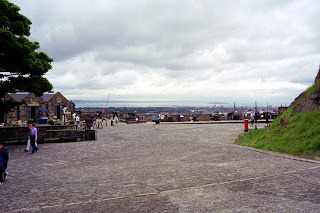 Cobbled plaza at Edinburgh Castle, Firth of Forth After the hotelbreakfast, we were taken to Holyrood Castle, which wasunfortunately closed as of today, to prepare security for the Royal Family'svisit on Sunday night. Holyrood was famous for its later occupants, Mary Queenof Scots, etc., but was started by David I, my ancestor, to memorialize hismother, St. Margaret, as the guest house for the nearby Holyrood Abbey, now inruins. We drove through the medieval streets, up the Royal Mile to Edinburgh Castle. We bought admission for £7.50,took a 30-minute guided tour, and then at leisure, we toured the crown jewelsand Stone of Scone ("skoon")exhibit. My ancestors sat on that stone to be consecrated or crowned king, fromKenneth MacAlpin in the 800s, to 1299, when my ancestor Edward I of England swiped it and carried it off to Westminster. Then everymonarch since has sat above it. Just a sandstone rock, but it's seen a lot ofroyal arse. Oh, sorry, revered ancestral spirits.
Cobbled plaza at Edinburgh Castle, Firth of Forth After the hotelbreakfast, we were taken to Holyrood Castle, which wasunfortunately closed as of today, to prepare security for the Royal Family'svisit on Sunday night. Holyrood was famous for its later occupants, Mary Queenof Scots, etc., but was started by David I, my ancestor, to memorialize hismother, St. Margaret, as the guest house for the nearby Holyrood Abbey, now inruins. We drove through the medieval streets, up the Royal Mile to Edinburgh Castle. We bought admission for £7.50,took a 30-minute guided tour, and then at leisure, we toured the crown jewelsand Stone of Scone ("skoon")exhibit. My ancestors sat on that stone to be consecrated or crowned king, fromKenneth MacAlpin in the 800s, to 1299, when my ancestor Edward I of England swiped it and carried it off to Westminster. Then everymonarch since has sat above it. Just a sandstone rock, but it's seen a lot ofroyal arse. Oh, sorry, revered ancestral spirits.Then I went to St.Margaret's Chapel, a barrel-vaulted little stone building, whitewashed inside,with small stained glass windows of St. Margaret and St. Columba (1800s). Therewere fresh flowers in the roped-off chancel. I could almost pray to thesainted ancestor, as millions have believed is right. As it is, I thanked Godpersonally, with no mediator, for allowing me to visit this place I've wantedto see for 20 years. It was a moving experience, and I was able to block out,for a minute, all the other tourists.
Our bus took us away at 1p.m., after the cannon was fired as a time keeper for the harbor. Walking fromthe hotel, I took 13 rolls of film for processing, got a sandwich in adepartment store café, took a narrated bus tour of Edinburgh, and shopped or browsed near thehotel. My feet are soooo bruised from walking the cobbles and the pavements.Ow, ow, ow. I wanted to shop in the touristy places in the Royal Mile, and seethe mews and closes, but just couldn't. Too painful!
Our tour-mate Dolores hasa single room on the seventh floor of the hotel, with a balcony that faces thewhole west front of Royal Mile. Edinburgh Castle is lit withfloodlights, and there was a break in the clouds so you could see the half moonshining over the castle. Took a picture of that.
Friday, June 29, 2001 , Edinburgh
What a long day. We hadto be ready for the day and on the bus at 6:20 a.m. We drove about four hoursnorthwest of Edinburgh to the west coast port of Oban. We were the last group to catchthe ocean ferry to Craignure, Mull. Our busdrove off the ferry there, and we went another hour, the length of the island,to a passenger ferry at Fionnport, which took us a mile or two across thestrait to Iona. While everyone else walked tothe abbey, I rented a bike and got up there that way. With my knees to mychest, I chugged up the path. It was my first time on a real bike (not thestationary kind) in some years. Pretty fun! I parked it on the shoulder outsidethe several churches, and prayed at the altars.
I stopped first at aruined stone church, and saw some ancient unmarked grave stones that might havebeen monks, priests, or my MacAlpin ancestors (or not), then rode along theblacktop path to the newer church down the road. I looked all over the churchesand graveyard for the ancient kings of Scotland said to be buried there.There were some uncarved or eroded tombs that looked ancient, but no modernplaque to identify.
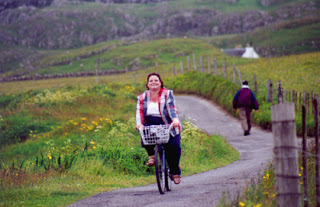 The day, which had beendrizzly on the drive and first ferry trip, cleared up miraculously while wewere on Iona. Two hours later, afterunmitigated gorgeosity (breeze, puffy clouds, warm and bright sun) just when itwas time to head back, a few drops from a squall started hitting, but notreally raining. It was exhilarating to ride the bike lickety-split downhill,into the teeth of the wind! Wheeeee.
The day, which had beendrizzly on the drive and first ferry trip, cleared up miraculously while wewere on Iona. Two hours later, afterunmitigated gorgeosity (breeze, puffy clouds, warm and bright sun) just when itwas time to head back, a few drops from a squall started hitting, but notreally raining. It was exhilarating to ride the bike lickety-split downhill,into the teeth of the wind! Wheeeee.I stayed out on the ferrydeck again, and watched a castle, a lighthouse, and sailboats pass my view.Donna and a cute kid (with an even cuter father) were feeding shortbread to aseagull as he floated in the boat's slipstream.
We reversed the ferriesand bus rides, along the same roads to Edinburgh,and were back by 9:30. I walked to Hard Rock Café and had soup, came back here,and then Michelle and Jimmie and I went to an Internet shop three blocks away,to do two hours of e-mail and web surfing. In case you're keeping track, it'snow 2 a.m. Saturday.
My impressions now:Everything is as green, or greener than, the Emerald Isle. On the morningdrive, it was raining in places and misty drizzle in others. As we drovethrough Perthand Crieff, and into the highlands, we saw much heavier runoff than we couldaccount for by rain. Must have been pouring at the mountain tops! We sawhundreds, maybe thousands, of considerable brooks and waterfalls. They'd justappear at the top of the crag, and within a few feet, were strong enough to beseen for miles. Inevitably, the creeks and waterfalls became burns and flowedinto the lochs. A couple of really large and beautiful ones were Lochearn andLochawe. Near the latter, at about the mid-journey point (if you count the longdrive on Mull Island) was the mountain, Ben Cruachan.My map says 1100 feet (must be meters); the guidebooks say 3600+. Coming fromthe mountainous US southwest, I wasn't expecting it to look like much. But Iwas impressed! It's all basalt covered in greenery, with shreds of mist for acrown, and waterfalls for a necklace. Puffs embroidered on its finery werethousands of sheep and lambs.
The first ferry ride, webarely drove on, and the boat took off. It was a bit rainy at first, but soonit was just damp and cold. Didn't keep me off the decks!
The island of Mullwas 40 minutes off the mainland, and looked similar. This time, we had only asingle lane, and we had to pull over for oncoming cars. The sheep and lambswalked through downed fences and grazed or ruminated on the shoulder or even onthe road. We saw highland cattle, which look like a devolved, retrograde breed.They're a pretty red color, with horns, and their hair is all shaggy, withbangs on their foreheads. Really interesting! Yak-ish. At the end of Mull is abroken-off island with two volcanic humps, Iona.
As the legend goes, St.Columcille/Columba came to this wild place, maybe on a day like today, with 12disciples, to found a monastery. When the guys decided this was tooascetic, treeless and rocky, and suggested going home, the future saint toldthem to burn the ships. The conquistador Cortez in 1519 did the same thing, andI used to think: what a waste of good transport, and how cruel. But the StevenCurtis Chapman song analogizes it to the Christian experience: we've come toofar to turn back now, our goal is still in front of us, Satan may block ourpaths, but we still have a victorious leader, Jesus.
Saturday, June 30 , 2001, Edinburgh
It was so sweet to sleep'til almost 9 a.m. The bus took us to the Adventist church in the Royal Mile,where our group took over the service. I played Brother James' Air foroffertory (it is Scottish!), and O Love that Wilt Not Let Me Gofor a piano solo. To precede the solo, I explained that the tune is called St.Margaret, and here we were a few blocks from St. Margaret's memorial chapel at Edinburgh Castle. I said I'd play to God's glory,and to my ancestress' memory. Kit, Robert, Donna, Nancy, Dorothy, and John alsocontributed heavily to the service. There was a three year-old girl there whowas so beautiful I could barely keep my eyes off her. She belonged to theorganist, Audrey. After the service, Audrey and granddaughter took me up to thebalcony to let me play the old pipe organ. The keys were stiff and uneven tothe touch, and the pedals seemed spaced slightly different than modern ones.The "presets" were three sets of levers you pushed with your foot,which unstopped certain voices. When Audrey played the prelude, though, it wasbeautiful, so she's found a way to overcome, maybe even exploit, the handicapsof the old instrument.
The church members serveda delicious lunch in their basement. The soup was pea and mint! I'm not sure ifI would choose that one again, but it was delicious for the once. I sat withsome Scottish ladies for lunch, and we chatted about their grown children andgrandchildren. At 2:30, we were taken back to our hotel, as our Scottish"sistern" and brethren waved from the front steps of the church.
In the afternoon, Iwalked all the way to, and on, the Royal Mile. I poked my head in the closesand listened to a piper. Tried to get into St. Giles' Cathedral, but it wasclosed. I had a pint milk carton to discard, but could find no trash, so Italked to a policeman. "Your city is really beautiful and clean, but Idon't understand how that's possible when there are no rubbish bins for blocksaround!" He smilingly responded that today was the Opening of Parliament, andthe Queen was coming tomorrow night… "Ah! No trash cans for securityreasons," I said, and he nodded.
I was at the entrance tothe Castle by about 5:30, but took a taxi back to the hotel because I wasmeeting Dorothy to taxi up to the bagpipe concert. However, she'd discoveredthere was no seating available, and we'd have to stand for a couple hours, soshe decided to miss the concert. Michelle and James, those youngwhippersnappers who had walked as much as I had and seemed just as exhausted,taxied with me instead.
The concert started at8:00, and we were there at 7 to get a good place. A security guard saw meleaning on my cane, and brought me his chair from the guard shack! So I got tosit, which was a blessing. (I'd never have made it back to the hotel later, otherwise.)We heard the rehearsals behind the castle walls, the pipes and the militaryband. Even though a bit muted by the thick stone walls and distance, it wasbeautiful. When they emerged from the gate and crossed the bridge, you'd getgoosebumps even if there wasn't an extremely frigid wind off the Firth ofForth/North Sea. (And there was.) What is it about bagpipes?
Instead of taking a taxiback, I strolled with Robert and Janet back down the mountain with its curvingcanyons of old buildings. We stopped for supper in a café. I hadbroccoli/asparagus soup. It tasted great, but it was pureed or strained, so nochunks. Then we continued our long walk back to the hotel.
After a long, hot footsoaking in the tub, bedtime.
Sunday, July 1 , 2001, 11:30 a.m., Holy Island, Lindisfarne, England
What a bucolic spot. I'msitting on a grassy bank at the harbor. To my right are two boats, keels up,with double doors at this end. Either they're boat houses or sheds forequipment. Three fishermen just walked by, and in their Yorkshireor Northumbrian accents, said, "It was six feet long." The guyschuckled, and one said on a gust of wind, "Yeah, right, and 150 pounds forsure." Fish stories.
There's a blond retrieverrunning around with a big doggie smile, and he met up with two friendly beagleswho bayed happily at him and wagged tails all around. There are sheep in apasture behind me. They were grazing quietly, but suddenly started doing thebaa-thing and moving en masse. There are some pretty sea birds who spotted mylunch bag and are squawking angrily at me. One flies over, and you see anexpectancy of chips or bread crusts in his beady eyes. Sorry. I have crackers,but I'm not sharing!
We drove south from Edinburgh this morning, along the coast route, with the North Sea on our left. What pretty country. Fields withred poppies, barley, or grazing sheep. Hilltop farmsteads. I was sitting in thejumpseat, as I've often done on this trip, snapping pictures out the front andleft windows. We stopped at the Scotland/England border to take photos, but bythen it was too late to see if we'd passed over Hadrian's Wall, because it was behind us. I never saw a sign for it, somaybe it doesn't reach the North Sea coast.Saw the sign for Thirsk, James Herriot's headquarters, and expected to seesteep hills and deep valleys like the AllCreatures movie and TV show. However, it was just a gently rollinglandscape.
Later: Here in Lindisfarne, I bought a piece of fish (no chips) from a vendor in aroach coach. This guy could have been a Herriot character if he' been born 70years ago! I asked where he was from, and he answered mostly monosyllabically, Yorkshire. Had he always lived around here? Yes. Do youhave tartar sauce? No. Brown sauce. (Tasted like barbecue plus ranch.) Whatkind of fish is in the filet? (Cod? Perch? Whitefish?) He opened the freezerand brought out an 8 x 12" box. "This kind," he said, and returned itto the freezer. So, the UKversion of Gorton's or Mrs. Paul's. (Unless they drop a net and the boxes floatup from the deep.) Oh, well, it was crispy and delicious. Best I've had inyears. I took my paper plate of fish up the road to the little village,munching all the way.
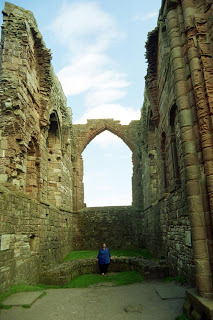 Found the museum to lookat the Lindisfarne Gospels on a computer (because the real thing is in theBritish Library in London),but decided to buy the CD rather than take time to look at it on theircomputer. Walked on to the priory, and paid admission to the museum and ruins.The apse was a semi-circle in which St. Cuthbert was probably buried at one time.I sat for awhile in the chancel, built in a semi-circle, on a block of stone,enjoying the perfect day: not too hot or cold, fluffy cumulus clouds in a pureblue sky, birds fluttering between the arches of the crossing, and the sunspotlighting me from a gothic stone arch. A golden moment. I was sitting at theplace where the high altar had been for 700 years, and bare stone had been foranother 600 years since. Then I heard God speak to my heart: "Presentyourself as a living sacrifice, holy and pleasing to God — this is yourspiritual act of worship." This moment was very powerful for me, there inthat quiet and holy place. God spoke. I was a living sacrifice on the stonealtar of a holy place.
Found the museum to lookat the Lindisfarne Gospels on a computer (because the real thing is in theBritish Library in London),but decided to buy the CD rather than take time to look at it on theircomputer. Walked on to the priory, and paid admission to the museum and ruins.The apse was a semi-circle in which St. Cuthbert was probably buried at one time.I sat for awhile in the chancel, built in a semi-circle, on a block of stone,enjoying the perfect day: not too hot or cold, fluffy cumulus clouds in a pureblue sky, birds fluttering between the arches of the crossing, and the sunspotlighting me from a gothic stone arch. A golden moment. I was sitting at theplace where the high altar had been for 700 years, and bare stone had been foranother 600 years since. Then I heard God speak to my heart: "Presentyourself as a living sacrifice, holy and pleasing to God — this is yourspiritual act of worship." This moment was very powerful for me, there inthat quiet and holy place. God spoke. I was a living sacrifice on the stonealtar of a holy place.The puffy clouds scuddedby peacefully, but it was nearly time to go. Back through the museum and giftshop, I found Lisa looking for gifts for Dorothy and John, in appreciation fromthe group. She'd picked out an assortment, and asked my opinion for the finaldecision. I thought John would like the Chi-Ro illumination because of theGreek letters that begin Christ's name. Dorothy had told me months before thather house, like mine, is all in blue and white, so I thought the blueCeltic-design plate would be a nice choice for her. Apparently, Dorothy andJohn had already been in this shop, and had salivated after the very thingsthat we decided upon, but we didn't know that until later!
When the bus got underwayat 2:30 p.m., the causeway was still wet, and the tidal flats still held a lotof water. We just got to the island in the nick of time this morning, and thenwe had three and a half hours to relax before we could leave. Time and tideswait for no one. How profound. Wish I'd made that up. I'd have been as famousas the guy who really did make it up. Born too late, I was. Oh, yeah, and in aland-locked desert city. So I doubt I would have thought of it anyway.
Durham and Yorkshire — About an hour or more down theroad, we hit Durham.The coach wasn't allowed in the medieval, twisty streets, and had to park atthe bottom of the very considerable hill. We started walking: up a hill, upstairs, up a small street, across a square, up a curvy street, up and up, andfinally, there was the gigantic cathedral. Just massive. We got a tour from asoft-spoken woman who showed us the tomb of St. Cuthbert, the nine chapels oraltars, took us into the chancel, and explained about the Caen limestone in the Neville Screen. HUH????
Neville, you say? I knewthe Lords Raby (Nevilles) were buried at important sites around Northumberlandand Yorkshire, and I remember there wereseveral Ralph Nevilles, Lord Raby. I told our docent/steward that I wasdescended from Nevilles and Percys and Ros, etc., and she got very interestedthat this American chick knew the ancient names and places. She's amedievalist, and lived in Alnwick Castle one summer, shesaid. That's a Percy place, and some are buried near there. (We'd passed theturnoff in our bus, and I only got a picture of the Alnwick sign.) The docentsaid that there were two Neville tombs in the cathedral, and then showed themto me while the rest of the group went with the guide. Photography isprohibited, and there were no postcards or guidebooks with pictures of thetombs. I asked if I could make a donation as I did at St. David's in Wales,but apparently, that too is out of the question. The docent whispered that shecould just disappear and I could snap the picture, and if the verger camearound, she could appear to scold me. So I got my shot and no one noticedanyway. Yea! I did buy postcards of the chancel and the Neville Screen, though.
We then hiked backdownhill, over cobbled streets. Those things kill my feet. I can see howthey'd be good traction in rain or snow, though. Janet and Robert had boughtMcDonald's ice cream sundaes for the whole busload. Really hit the spot. Howdid they haul 23 cups of ice cream all the way to the bus?
11 p.m., York, Yorkshire, England — Wow. Ancient city walls. York Minster. Funnystreets like Whip-Ma-Whop-Ma-Gate. Cobbles, bricks, stone buildings andsidewalks. Our hotel room looks right out at the north city wall. We had thegroup dinner tonight, and presented the gifts to Dorothy and John, who werethrilled with the choices. The hotel restaurant served this great soup, and Iasked if I could just have another serving of soup instead of the entrée. Theylooked at me strangely, but said okay. Crazy American, only eating thepotato/leek soup.
Even though sore andtired from all the walking already today, I convinced Michelle and James to gowalking into the old city, only a block away through the Monkbar Gate. We sawthe east face of the Minster, the largest medieval building in the UK,then we walked down a few streets looking for a convenience market. Nothing butpubs after 10 p.m. on a Sunday night. Finally found a roach coach with bottledspring water. Then we turned to come back, and we'd gone really far! Maybe amile each way. And we were tired to begin with. Now I ache. Probably willtomorrow, too. I just BET I'll find more graves or mentions. My families ruled York for hundreds ofyears.
All the blue blood in myveins is throbbing in my feet and knees and hips. Must soak and medicate!
Read on to Celtic Britain part 4.
Published on July 30, 2011 12:56
Celtic Britain travel journal II
Celtic BritainTRAVEL JOURNAL--part 2 (Wales and Ireland)
Friday, June 22, 2001, 10:40 p.m., Dublin, Ireland
It's still twilight, evenat this hour. We reached the hotel an hour ago, and I've been out to find anATM. I just insert my Bank of America debit card, input the PIN, and out comes£50 Irish money. Such a deal, and so much easier than money changers orordering currency at the bank at home.
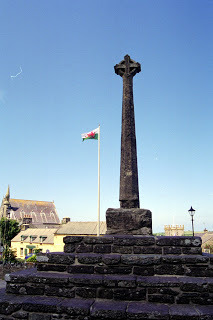 Market cross, Welsh flag, St. David's in background Today began with packingup, riding the bus across South Wales(Glamorgan), through rolling hills with bazillions of sheep and milk cattle.The hedgerows, which line every road, were very often tall enough to block mytaking photos. There would have been vistas in the soft haze, with gentle greenslopes dotted with sheep, hedgerows of shaggy blackberry vines and ferns, stonewalls with lobelia and foxglove growing from the gaps, and occasionally, as wecame close to the coast, half a horizon of deep blue Irish Sea. We dipped below the sea cliffs several times, and foundinlets with sailboats standing on their double keels in the mud — maybe 20-30of them. Perhaps with the new moon, the tide is exceptionally low. We drovewest from Newport, past Swansea,through Carmarthen (missed the castle), through Haverford West (wanted toinvestigate castle ruin, but no time), past St. Brides Bay to St.David's in Dyfdd.
Market cross, Welsh flag, St. David's in background Today began with packingup, riding the bus across South Wales(Glamorgan), through rolling hills with bazillions of sheep and milk cattle.The hedgerows, which line every road, were very often tall enough to block mytaking photos. There would have been vistas in the soft haze, with gentle greenslopes dotted with sheep, hedgerows of shaggy blackberry vines and ferns, stonewalls with lobelia and foxglove growing from the gaps, and occasionally, as wecame close to the coast, half a horizon of deep blue Irish Sea. We dipped below the sea cliffs several times, and foundinlets with sailboats standing on their double keels in the mud — maybe 20-30of them. Perhaps with the new moon, the tide is exceptionally low. We drovewest from Newport, past Swansea,through Carmarthen (missed the castle), through Haverford West (wanted toinvestigate castle ruin, but no time), past St. Brides Bay to St.David's in Dyfdd.
St. David is the patronsaint of Wales.He was an apostle to my wild Welsh ancestors, and turned them from druidism toChristianity. We had an hour to hustle down a steep street, stairs, anothersteep path, and then into the cathedral. (About half the group took the wrongstreet, and ended up at St. Non's church, in honor of St. David's mother.Oops.) It was very interesting where I went! I read some churchyard andinterior grave stones. Every grave faces east, as does the chancel. Again, Iprayed at the high altar, as several (or many) ancestors must have done. Ifound the sarcophagus of Edmund Tudor (brother of Henry VII), who was a firstor second cousin to my ancestors. And I found the ossuary of St. David. I hadto hurry up the steep walk, the stairs, and the steep street to get back to themeeting point, but the coach wasn't back yet, so I had a cup of coffee withDolores in a shop. (This British coffee needs a lot of milk, I've found. Thetea is better.)
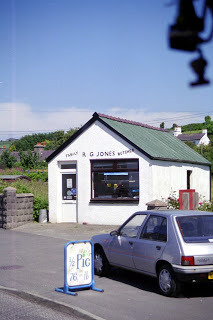 "Family butcher." YIKES!! We headed northeast toFishguard, another Newport,through Cardigan, Abermeron, and Aberystwyth (after which a hymn is named). Itook a photo through the trees and bushes, of the church there. Must be somechurch or town, if they named the hymn after it. Somewhere around there, weentered Powys. It was pretty country already, but now we found more forest andgradually higher and more rugged volcanic mountains. It was, incredibly, a moreintense green. The forests thickened, and it was easy to image the Welshpatriots materializing to fight the conquering English, then melting back intothe forest. When we passed Machynlleth, we started up a glacial valley.
"Family butcher." YIKES!! We headed northeast toFishguard, another Newport,through Cardigan, Abermeron, and Aberystwyth (after which a hymn is named). Itook a photo through the trees and bushes, of the church there. Must be somechurch or town, if they named the hymn after it. Somewhere around there, weentered Powys. It was pretty country already, but now we found more forest andgradually higher and more rugged volcanic mountains. It was, incredibly, a moreintense green. The forests thickened, and it was easy to image the Welshpatriots materializing to fight the conquering English, then melting back intothe forest. When we passed Machynlleth, we started up a glacial valley.
I could imagine my Welshpeople building those rock fences, carrying water, hunting deer, racing horsesby the river, singing and harping by the fire in winter, and tending sheep. Ifelt such a bond with these anonymous Welsh people from hundreds of years ago.It's not like I share any of their experience or their DNA after all thesegenerations of dilution. It's that, as I learn about their lives, who theywere, what they felt and how they reacted, I take in part of their spirit andthey grow and live inside me. It's a mysterious feeling, this Circle of Life. Idon't believe in Fate. I'm not pre-destined to believe or act in a way that myforebears did. But I choose, willfully, to be a hardworking, independent,educated, opinionated, free spirit who also (paradoxically) knows when conservatismmight be warranted.
This quick drive throughWales, even though we didn't have one minute to drive slowly past a place ofinterest (like standing stones at Portmeirion and Carnarvon, or even CarnarvonCastle), was still an epic journey. We were hurrying to catch our 6:30 p.m.Holyhead, Anglesey, ferry to Dun Laoghaire, Ireland.
We drove up in a lather,almost, at 6:20. We drove the bus right into the huge ship. It was a hydrofoilor catamaran, I think, and we did about 50 mph across the Irish Sea. Beautiful weather, with a warm, strong sun and chilly windoff the water. In less than two hours, we'd crossed the water and drove offinto the agriculture inspection. There has been a foot and mouth diseaseoutbreak in Britain and Europe, and we were walked across disinfectant mats andthe bus was sprayed around and under, with disinfectant (so now we really werein a lather!) at the Irish port. Our Dublinhotel room is downtown, and there are thousands of young people in the streetsthis Friday night, drinking and smoking.
I must sleep!!!!
Saturday, June 23, 2001 , 5:30 p.m., Dublin
Well, no need to comeback here any time soon, unless they pass a smoking ban. Everyone smokes vile cigarettes, nonstop it seems. Thehotel corridors and lifts and especially the lobby by the ubiquitous bar — all just reek. My throat and eyes burn with it. Makes menauseous, too. Need to break out the inhaler. The streets are absolutely jammedwith young people. They're not carrying shopping, just walking and wandering. Idon't see the attraction of standing packed into a smoky bar (too jammed to getserved), not able to talk to your date because of the loud music. The foodsmells here are great, though.
We were bused to theDublin SDA church for study and worship. The pastor suggested I try the pianobefore the service, to get the feel. So I played a few lines of a hymn to warmup. The pianist came over and fussed with hymnals on top of the studio piano,and looked very cross that I was on HER piano bench. I hastened to get off the bench, andtold her, no, I wasn't playing for the hymns, I was just warming up. She satdown and played for song service, and once she put her foot down on the damperpedal, that foot never lifted for the next 10 minutes.
I'd say the church wouldfit 70. With our 22 people, they had to bring in seven extra chairs. I played BrotherJames' Air (The Twenty-third Psalm), and tour member Donna played herpsaltery, doing The Water is Wide. The pastor had to leave for his otherdistrict church, so a woman preached. Who knows on what: I was sofighting jet lag.
After church and changingclothes, I bought some food at a convenience market for lunch, then joined thegroup for a narrated tour of Dublinon our coach. We were set down at Trinity College to see the Bookof Kells on display. In an environmentally controlled case in a dark room, Isaw this 1200-year-old book of Gospels, drawn on vellum. I liked the humorinserted into the fanciful illuminations. The artists couldn't have known theirwork would be seen and admired and even revered after 1200 years! If I believedmy work would be worth that much so far down the line, how much more exactingwould be my labors! How much more care and thought would go into the planning!
As I exited the exhibit,my stomach was cramping, and I was overcome by more vile smoke coming in theopen door of the gift shop. I was sick in the gift shop store-room bathroom.Then after that, I had to walk 3-4 blocks through the crowds, past MollyMalone's cockles and mussels, before I could get back to my room and puff onthe albuterol.
11:30 p.m.: The noise inthe street below is increasing exponentially, as the people get more blotto.There's nothing but bar after pub after licensed establishment after nightclubout in Temple Bar, which is the district this hotel is in. After I got backfrom seeing the Book of Kells, I took a 45-minute nap, then went to the tourgroup dinner in a private room over a pub. The group told a bit of who theywere and how they came to be on the trip. After supper, tea was served. Kit andCherrie confused the paper packets in the serving dish, and instead usedpackets of salt and pepper in their tea. The waiters must have rolled on thefloor laughing. I walked around Temple Bar and over to the River Liffey, whereI stood for a while on the bridge to get some air before returning here. Nowthere's a British comedy show on TV: short takes of comedy sketches. Fasterpaced than Saturday Night Live, but still ensemble based.
Sunday, June 24, 2001 , 11 p.m., Cork, Ireland
Ow. I'm sitting on thenarrow edge of the bathtub, soaking my feet in the hottest water I can bear.
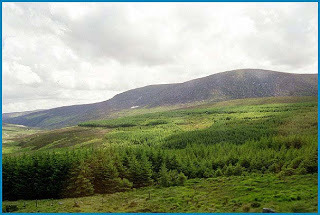 Wicklow Mtns near Glendalough
Wicklow Mtns near Glendalough
Today was a good one. Weleft beautiful but stinky-smoky Dublin!A couple hours' drive south are the Wicklow Mountains. Really prettycountry. I could barely stay awake on the drive, but I'm forcing myself not tomiss a thing. (Some of the tour members are sleeping through the whole trip, itseems. They wake when the bus stops. But we're always in the bus!)
Our first stop was theGlendalough Abbey ruins, and the lakes where naked women tried to seduce St.Kevin. (He pushed one off his hermit's ledge, and she died from the fall ordrowned, I'm not sure.) The ruins of a very old scriptorium and church werevery pretty. I planned to visit the lower lake, but tripped on a stone in thepath, and fell. So instead I went back to the visitor center to wash up andbandage my palm. We had a group lunch at the Glendalough restaurant (somebizarre veggie medley, not good), and shopped for 10 minutes.
We then bused through theWicklow Gap (a glacial valley and mountain pass). After a lifetime of seeingpictures of ruins (abbeys, churches, monasteries, houses, castles, and keeps),it's almost not amazing to see so many of them for myself. Through thetrees, I glimpse a Norman square church tower, or gothic spires. Sometimes the900 year-old keep is attached to a 400 year-old house, or a house that was oncea crofter's shed is now a cottage or sheep shed. The longer buildings wereprobably a stable at one end and home at the other.
Our next stop was theRock of Cashel, a 13th century abbey and castle, and one of St.Patrick's missionary sites. The weather is still gorgeous, and we climb aroundin the sun and wind. The views are incredible, and with the long, long days,the sun is still quite high at 6 p.m..
After two more hours ofdriving, we came to Cork,near the bottom of the island. We got our rooms (nice hotel — quiet, view ofquiet river, no smoky pubs in sight!), then most of us took off walking andexploring. Mind you, this was after 9 p.m. on a Sunday! Only one shop was open,a convenience store which had Internet terminals, £1 per 20 minutes. Janet andRobert and I checked all our e-mail accounts and answered several notes. Nexttime, I'll send messages to Brian, Jan J., Jan K., Nancy, etc.
Janet and Robert and Igot iced drinks at McDonalds and came back to get ready for tomorrow.
Monday, June 26 , 2001, 10 p.m., Limerick, Ireland
I'm sitting in the hotelcourtyard (I think close to Shannon Airport), maybe threemiles from King John's Castle on the River Shannon. (Evil King John, who wasforced to sign the Magna Carta by his barons, some of whom are my ancestors,was also a forebear of mine.) We probably can't go see it, because it's notCeltic (it's English/Norman), and it would really screw up our packeditinerary. We always seem to hit the hotels after 8 p.m., long after the townshops close at 6, and we leave town again at 9 a.m., before the places open! Iasked Dr. Jones if we might visit the castle first thing tomorrow, and he saidhe'd ask around for consensus. So maybe.
Today was anothergorgeous day. We left Cork at 9 and went 8 kmsto Blarney Castle. I skipped the 120 steps andhanging upside down to kiss a dirty rock (yes, the famous Blarney Stone), andwent with most others to shop at the factory outlet. Got gifts for Dad andSusanne, a teal wool ruana for me, had my photo taken by Christy's Pub, and then we bused across the south of Irelandto the Dingle Peninsula.
We saw bogs, lakes, lotsof sheep and cattle (no goats, hmmm…), stone fences, Norman and gothic churches both ruined andrestored. I noticed some stone outbuildings had ancient shapes still evident incross section, then they were altered to have added height or different roofline.Across the valleys, we could see the remains of round towers or the skeletonsof castles. Everywhere are stone fences, running around irregularly shapedpastures or hayfields, lining the roads, running up hillsides, shoring up steepplaces. I asked if the rocks were quarried, or just gathered and stacked afterbeing left by glaciers. The answer is the latter. So our Celtic ancestorscarted rocks around, cleared fields, built fences and walls, in addition toevery other survival skill and leisure arts. We made a restroom stop at Inch Beach,a pretty bay. The women's restroom was out of TP entirely. Catalino had tosteal a roll of tissue from the men's room to help out the desperate women whowould otherwise have had to wait 'til the next stop.
We lunched at Dingle, afishing village/tourist trap. Actually, it was really pretty, and I had theopportunity to run up the hill to the first supermarket I've seen in thiscountry. I bought spring water, crackers and milk, and film.
After lunch, we found astone beehive hut, the Gallarus Oratory, from 1400 years ago. We swarmed aroundand took photos and heard about monastic life and the copying of manuscripts.Penny took a picture of me "pulling" out a stone from the dry masonryfoundation. Sort of like pulling the bottom can of soup on the shelf. Me? TheUgly Tourist?
Back on the bus, I had topresent my paper on Celtic-era musical instruments, reading into the microphoneas we bumped along. I skipped over whole portions of the paper, and no oneprotested, so maybe they were all asleep. Then I unloaded the copies I'dbrought, for their notebook collection. Dr. Comm said she thought "thegods would smile kindly" on me when it's time for a grade.
Then we drove and droveand drove, and came to Limerick, as I said, about8:00. We drove past the castle and I snapped one or two through the window.Some of us went next door to the restaurant for dinner. I just had a hotchocolate, and a slice of rye bread. I tried to write this entry in the hotelcourtyard, but 15 people came out to be sociable, so I put it away 'til now.
Tuesday, June 27, 2001 , Navan, Ireland (50 miles northwest of Dublin)
It was drizzling andovercast this morning when we went down to breakfast. It's really nice, evenso. Although we couldn't take time for the castle tour, we at least stopped atKing John's castle for some pix. I shared some stories about Bad King John withsome of our tour members.
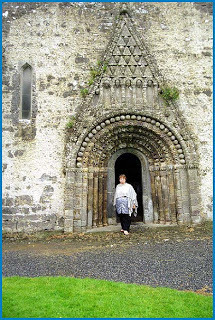 Clonfert Our first visit was toClonfert Cathedral, a rather small stone church in the countryside near theRiver Shannon. It's a Protestant Church of Ireland site, and I doubt it getsmuch business, since 90% of the Republic of Ireland is Catholic.(I'm sure there are a few atheists and Hindus and Muslims, evangelicals, andthe odd Adventist, among the 10%.) Anyway, the tiny Romanesque church entry isprobably from around 1000 years ago to judge by the barrel arches, but1200-1400 years ago to judge by the carvings. Little disembodied heads of stonedecorated the round arch. That's actually a holdover from the pagan Celts decoratingtheir camps or forts with enemies' heads. The power of the slain warrior istransferred to the victor with the taking of the head. Inside the church, wefound birds flying around, a locked pipe organ (very, very old), stonecarvings, and Celtic symbolism, as well as modern benches for worshipers, andbig electric space heaters stored in the back. The church is associated withSt. Brendan the Navigator (he may have visited Iceland,Greenland, and Canada),and it's believed he's buried there. At the chancel entrance is carved amermaid holding a Gospel book in her hand. The bishop's chair had a carvedpanel of Brendan with seaweed and fishes. I was impressed that at some time,the church was rebuilt bigger and higher, but retained the original Celtic art.
Clonfert Our first visit was toClonfert Cathedral, a rather small stone church in the countryside near theRiver Shannon. It's a Protestant Church of Ireland site, and I doubt it getsmuch business, since 90% of the Republic of Ireland is Catholic.(I'm sure there are a few atheists and Hindus and Muslims, evangelicals, andthe odd Adventist, among the 10%.) Anyway, the tiny Romanesque church entry isprobably from around 1000 years ago to judge by the barrel arches, but1200-1400 years ago to judge by the carvings. Little disembodied heads of stonedecorated the round arch. That's actually a holdover from the pagan Celts decoratingtheir camps or forts with enemies' heads. The power of the slain warrior istransferred to the victor with the taking of the head. Inside the church, wefound birds flying around, a locked pipe organ (very, very old), stonecarvings, and Celtic symbolism, as well as modern benches for worshipers, andbig electric space heaters stored in the back. The church is associated withSt. Brendan the Navigator (he may have visited Iceland,Greenland, and Canada),and it's believed he's buried there. At the chancel entrance is carved amermaid holding a Gospel book in her hand. The bishop's chair had a carvedpanel of Brendan with seaweed and fishes. I was impressed that at some time,the church was rebuilt bigger and higher, but retained the original Celtic art.
I've seen barns andhouses built up that way. I've also seen city walls melt into castle walls,with bricked-up window or door arches. I could visualize a window in a row ofwindows, with lean-to buildings or sheds behind the stone wall, as probablyshop counters on market day.
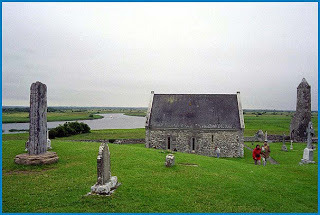 Clonmacnoise Abbey Anyway, next stop wasClonmacnoise Abbey, with Celtic high crosses and ruined churches, and hundredsof tomb stones. It was a very impressive sight on a hill above River Shannon.The Whispering Arch was interesting, and the clusters of stone churches, ruinedfor centuries, were pretty. Our docent/guide was very entertaining, and had thebest Irish accent I've heard so far. (Whatever that means, I'm sure she'd say.However, I think she'd be perfect for a Maeve Binchy novel.) The drizzle hadstopped, but the chilly wind whipped around. Still no complaints on theweather. It's what makes Irelandthe Emerald Isle, and its lack thereof is what makes the desert southwest sobrown and scorched this time of year.
Clonmacnoise Abbey Anyway, next stop wasClonmacnoise Abbey, with Celtic high crosses and ruined churches, and hundredsof tomb stones. It was a very impressive sight on a hill above River Shannon.The Whispering Arch was interesting, and the clusters of stone churches, ruinedfor centuries, were pretty. Our docent/guide was very entertaining, and had thebest Irish accent I've heard so far. (Whatever that means, I'm sure she'd say.However, I think she'd be perfect for a Maeve Binchy novel.) The drizzle hadstopped, but the chilly wind whipped around. Still no complaints on theweather. It's what makes Irelandthe Emerald Isle, and its lack thereof is what makes the desert southwest sobrown and scorched this time of year.
Well, back on the bus weclimbed for another couple hours. We passed more cattle than sheep, quite a fewNorman churches, maybe five or seven castle keeps, and some unidentifiable butromantic stone remains. One was a couple of walls, a tower broken in half thevertical way, and vines softened all the edges. Sheep grazed right in thebailey. At one River Shannon crossing, I saw a low, fat, round castle keep in the"front yard" of a modern house. SUVs were parked next to the keep.
Our final destination wasthe visitor center for Newgrange Barrow, a Neolithic barrow built long beforethe pyramids, out on a high hill by the River Boyne. Apparently, you have tohave reservations a couple years in advance, for a group, and we were too latein the day to be able to hike around the barrow. But at the interpretationcenter, we viewed an A/V presentation, and went into a hallway with cast stonereplicated from the real barrow, which is on the hill across the Boyne, about a mile away. The rocks inside were big slabsof stone laid in a spiraling corbel, dry masonry method, at the end of a longpassage of even more upright slabs. Then rocks and gravel and finally earthwere heaped over it. White quartz rock from the Wicklow Mountains,maybe 60-70 miles south as the crow flies, was hauled to face the sides of thishuge monument. Since Neolithic people couldn't do a lot of flying, theyor their beasts of burden had to drag the rocks over hill and dale, aroundlakes and bogs, and through rivers and streams. If I was a Neolithic woman, I'dfeel compelled to tell my death-obsessed priest, "Sorry. I don't do rocks.This religion needs to get a life!" And then he'd probably sacrifice me atthe front door of the barrow. Still better than hauling rocks, I say.
Now we're back at thehotel in Navan, having had dinner.
Wednesday, June 28,2001
We left Navan for nearbyKells (as in Book Of), which was a monastic town where St. Columba/Columcillelived. We went through the interpretive center, seeing a video and a very nicemuseum. All the exhibits were replicas, but we couldn't tell the difference,anyway.
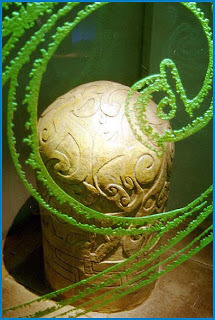 We bused north to Newly,and over the Mourne Mountain range into Northern Ireland. There was nocheckpoint on our side, but the Garda (Republic of Irelandpolice) had one on the southbound side. They must be pickier about who getsinto the Republic than the Northern Ireland folks are. There's been violence in Belfast the last week,after a long time of relative ease. Gasoline bombs had been thrown at police.
We bused north to Newly,and over the Mourne Mountain range into Northern Ireland. There was nocheckpoint on our side, but the Garda (Republic of Irelandpolice) had one on the southbound side. They must be pickier about who getsinto the Republic than the Northern Ireland folks are. There's been violence in Belfast the last week,after a long time of relative ease. Gasoline bombs had been thrown at police.
We didn't go straightthere: we went to Downpatrick, which was a really good choice. They had abeautifully designed multimedia presentation at the visitors' center. Patrick, ifone believes what is written by him (I do) and about him (well, some), was anapostle to the Irish. He seemed to have a real understanding of God's grace.The video, as good as an IMAX, showed aerial shots of the places Patrickministered. On the way out, I bought an incredibly beautiful stained glassgoblet with Celtic designs for £37, about $54 US. It would be $200 at a U.S.studio, I'm sure. They'll ship it to me.
Then we drove north a bitmore to Belfast.It was just a busy, late-afternoon day like any other. We saw a Sinn Feinoffice and political poster, but no demonstrations. Just uniformed boys inshort pants, walking home from school.
Our driver Charlie foundthe docks, and before they allowed our bus to drive onto the ferry, a securityofficer boarded and looked at each of us, and glanced over our suitcases in thehold of the bus. He didn't smile or act friendly, and I'm sure we all lookedfairly solemn, as well. We treated it as a security point at an airport. Wedrove onto the ferry, and all of us went up to the passenger deck. It wasinteresting that Ireland andScotland are so close at theBelfast-Stranraer beeline, that you can see both countries from the middle ofthe Irish Sea.
Be sure to read on to Celtic Britain Travel Journal Part 3 (Scotland, north England)

Friday, June 22, 2001, 10:40 p.m., Dublin, Ireland
It's still twilight, evenat this hour. We reached the hotel an hour ago, and I've been out to find anATM. I just insert my Bank of America debit card, input the PIN, and out comes£50 Irish money. Such a deal, and so much easier than money changers orordering currency at the bank at home.
 Market cross, Welsh flag, St. David's in background Today began with packingup, riding the bus across South Wales(Glamorgan), through rolling hills with bazillions of sheep and milk cattle.The hedgerows, which line every road, were very often tall enough to block mytaking photos. There would have been vistas in the soft haze, with gentle greenslopes dotted with sheep, hedgerows of shaggy blackberry vines and ferns, stonewalls with lobelia and foxglove growing from the gaps, and occasionally, as wecame close to the coast, half a horizon of deep blue Irish Sea. We dipped below the sea cliffs several times, and foundinlets with sailboats standing on their double keels in the mud — maybe 20-30of them. Perhaps with the new moon, the tide is exceptionally low. We drovewest from Newport, past Swansea,through Carmarthen (missed the castle), through Haverford West (wanted toinvestigate castle ruin, but no time), past St. Brides Bay to St.David's in Dyfdd.
Market cross, Welsh flag, St. David's in background Today began with packingup, riding the bus across South Wales(Glamorgan), through rolling hills with bazillions of sheep and milk cattle.The hedgerows, which line every road, were very often tall enough to block mytaking photos. There would have been vistas in the soft haze, with gentle greenslopes dotted with sheep, hedgerows of shaggy blackberry vines and ferns, stonewalls with lobelia and foxglove growing from the gaps, and occasionally, as wecame close to the coast, half a horizon of deep blue Irish Sea. We dipped below the sea cliffs several times, and foundinlets with sailboats standing on their double keels in the mud — maybe 20-30of them. Perhaps with the new moon, the tide is exceptionally low. We drovewest from Newport, past Swansea,through Carmarthen (missed the castle), through Haverford West (wanted toinvestigate castle ruin, but no time), past St. Brides Bay to St.David's in Dyfdd.St. David is the patronsaint of Wales.He was an apostle to my wild Welsh ancestors, and turned them from druidism toChristianity. We had an hour to hustle down a steep street, stairs, anothersteep path, and then into the cathedral. (About half the group took the wrongstreet, and ended up at St. Non's church, in honor of St. David's mother.Oops.) It was very interesting where I went! I read some churchyard andinterior grave stones. Every grave faces east, as does the chancel. Again, Iprayed at the high altar, as several (or many) ancestors must have done. Ifound the sarcophagus of Edmund Tudor (brother of Henry VII), who was a firstor second cousin to my ancestors. And I found the ossuary of St. David. I hadto hurry up the steep walk, the stairs, and the steep street to get back to themeeting point, but the coach wasn't back yet, so I had a cup of coffee withDolores in a shop. (This British coffee needs a lot of milk, I've found. Thetea is better.)
 "Family butcher." YIKES!! We headed northeast toFishguard, another Newport,through Cardigan, Abermeron, and Aberystwyth (after which a hymn is named). Itook a photo through the trees and bushes, of the church there. Must be somechurch or town, if they named the hymn after it. Somewhere around there, weentered Powys. It was pretty country already, but now we found more forest andgradually higher and more rugged volcanic mountains. It was, incredibly, a moreintense green. The forests thickened, and it was easy to image the Welshpatriots materializing to fight the conquering English, then melting back intothe forest. When we passed Machynlleth, we started up a glacial valley.
"Family butcher." YIKES!! We headed northeast toFishguard, another Newport,through Cardigan, Abermeron, and Aberystwyth (after which a hymn is named). Itook a photo through the trees and bushes, of the church there. Must be somechurch or town, if they named the hymn after it. Somewhere around there, weentered Powys. It was pretty country already, but now we found more forest andgradually higher and more rugged volcanic mountains. It was, incredibly, a moreintense green. The forests thickened, and it was easy to image the Welshpatriots materializing to fight the conquering English, then melting back intothe forest. When we passed Machynlleth, we started up a glacial valley. I could imagine my Welshpeople building those rock fences, carrying water, hunting deer, racing horsesby the river, singing and harping by the fire in winter, and tending sheep. Ifelt such a bond with these anonymous Welsh people from hundreds of years ago.It's not like I share any of their experience or their DNA after all thesegenerations of dilution. It's that, as I learn about their lives, who theywere, what they felt and how they reacted, I take in part of their spirit andthey grow and live inside me. It's a mysterious feeling, this Circle of Life. Idon't believe in Fate. I'm not pre-destined to believe or act in a way that myforebears did. But I choose, willfully, to be a hardworking, independent,educated, opinionated, free spirit who also (paradoxically) knows when conservatismmight be warranted.
This quick drive throughWales, even though we didn't have one minute to drive slowly past a place ofinterest (like standing stones at Portmeirion and Carnarvon, or even CarnarvonCastle), was still an epic journey. We were hurrying to catch our 6:30 p.m.Holyhead, Anglesey, ferry to Dun Laoghaire, Ireland.
We drove up in a lather,almost, at 6:20. We drove the bus right into the huge ship. It was a hydrofoilor catamaran, I think, and we did about 50 mph across the Irish Sea. Beautiful weather, with a warm, strong sun and chilly windoff the water. In less than two hours, we'd crossed the water and drove offinto the agriculture inspection. There has been a foot and mouth diseaseoutbreak in Britain and Europe, and we were walked across disinfectant mats andthe bus was sprayed around and under, with disinfectant (so now we really werein a lather!) at the Irish port. Our Dublinhotel room is downtown, and there are thousands of young people in the streetsthis Friday night, drinking and smoking.
I must sleep!!!!
Saturday, June 23, 2001 , 5:30 p.m., Dublin
Well, no need to comeback here any time soon, unless they pass a smoking ban. Everyone smokes vile cigarettes, nonstop it seems. Thehotel corridors and lifts and especially the lobby by the ubiquitous bar — all just reek. My throat and eyes burn with it. Makes menauseous, too. Need to break out the inhaler. The streets are absolutely jammedwith young people. They're not carrying shopping, just walking and wandering. Idon't see the attraction of standing packed into a smoky bar (too jammed to getserved), not able to talk to your date because of the loud music. The foodsmells here are great, though.
We were bused to theDublin SDA church for study and worship. The pastor suggested I try the pianobefore the service, to get the feel. So I played a few lines of a hymn to warmup. The pianist came over and fussed with hymnals on top of the studio piano,and looked very cross that I was on HER piano bench. I hastened to get off the bench, andtold her, no, I wasn't playing for the hymns, I was just warming up. She satdown and played for song service, and once she put her foot down on the damperpedal, that foot never lifted for the next 10 minutes.
I'd say the church wouldfit 70. With our 22 people, they had to bring in seven extra chairs. I played BrotherJames' Air (The Twenty-third Psalm), and tour member Donna played herpsaltery, doing The Water is Wide. The pastor had to leave for his otherdistrict church, so a woman preached. Who knows on what: I was sofighting jet lag.
After church and changingclothes, I bought some food at a convenience market for lunch, then joined thegroup for a narrated tour of Dublinon our coach. We were set down at Trinity College to see the Bookof Kells on display. In an environmentally controlled case in a dark room, Isaw this 1200-year-old book of Gospels, drawn on vellum. I liked the humorinserted into the fanciful illuminations. The artists couldn't have known theirwork would be seen and admired and even revered after 1200 years! If I believedmy work would be worth that much so far down the line, how much more exactingwould be my labors! How much more care and thought would go into the planning!
As I exited the exhibit,my stomach was cramping, and I was overcome by more vile smoke coming in theopen door of the gift shop. I was sick in the gift shop store-room bathroom.Then after that, I had to walk 3-4 blocks through the crowds, past MollyMalone's cockles and mussels, before I could get back to my room and puff onthe albuterol.
11:30 p.m.: The noise inthe street below is increasing exponentially, as the people get more blotto.There's nothing but bar after pub after licensed establishment after nightclubout in Temple Bar, which is the district this hotel is in. After I got backfrom seeing the Book of Kells, I took a 45-minute nap, then went to the tourgroup dinner in a private room over a pub. The group told a bit of who theywere and how they came to be on the trip. After supper, tea was served. Kit andCherrie confused the paper packets in the serving dish, and instead usedpackets of salt and pepper in their tea. The waiters must have rolled on thefloor laughing. I walked around Temple Bar and over to the River Liffey, whereI stood for a while on the bridge to get some air before returning here. Nowthere's a British comedy show on TV: short takes of comedy sketches. Fasterpaced than Saturday Night Live, but still ensemble based.
Sunday, June 24, 2001 , 11 p.m., Cork, Ireland
Ow. I'm sitting on thenarrow edge of the bathtub, soaking my feet in the hottest water I can bear.
 Wicklow Mtns near Glendalough
Wicklow Mtns near GlendaloughToday was a good one. Weleft beautiful but stinky-smoky Dublin!A couple hours' drive south are the Wicklow Mountains. Really prettycountry. I could barely stay awake on the drive, but I'm forcing myself not tomiss a thing. (Some of the tour members are sleeping through the whole trip, itseems. They wake when the bus stops. But we're always in the bus!)
Our first stop was theGlendalough Abbey ruins, and the lakes where naked women tried to seduce St.Kevin. (He pushed one off his hermit's ledge, and she died from the fall ordrowned, I'm not sure.) The ruins of a very old scriptorium and church werevery pretty. I planned to visit the lower lake, but tripped on a stone in thepath, and fell. So instead I went back to the visitor center to wash up andbandage my palm. We had a group lunch at the Glendalough restaurant (somebizarre veggie medley, not good), and shopped for 10 minutes.
We then bused through theWicklow Gap (a glacial valley and mountain pass). After a lifetime of seeingpictures of ruins (abbeys, churches, monasteries, houses, castles, and keeps),it's almost not amazing to see so many of them for myself. Through thetrees, I glimpse a Norman square church tower, or gothic spires. Sometimes the900 year-old keep is attached to a 400 year-old house, or a house that was oncea crofter's shed is now a cottage or sheep shed. The longer buildings wereprobably a stable at one end and home at the other.
Our next stop was theRock of Cashel, a 13th century abbey and castle, and one of St.Patrick's missionary sites. The weather is still gorgeous, and we climb aroundin the sun and wind. The views are incredible, and with the long, long days,the sun is still quite high at 6 p.m..
After two more hours ofdriving, we came to Cork,near the bottom of the island. We got our rooms (nice hotel — quiet, view ofquiet river, no smoky pubs in sight!), then most of us took off walking andexploring. Mind you, this was after 9 p.m. on a Sunday! Only one shop was open,a convenience store which had Internet terminals, £1 per 20 minutes. Janet andRobert and I checked all our e-mail accounts and answered several notes. Nexttime, I'll send messages to Brian, Jan J., Jan K., Nancy, etc.
Janet and Robert and Igot iced drinks at McDonalds and came back to get ready for tomorrow.
Monday, June 26 , 2001, 10 p.m., Limerick, Ireland
I'm sitting in the hotelcourtyard (I think close to Shannon Airport), maybe threemiles from King John's Castle on the River Shannon. (Evil King John, who wasforced to sign the Magna Carta by his barons, some of whom are my ancestors,was also a forebear of mine.) We probably can't go see it, because it's notCeltic (it's English/Norman), and it would really screw up our packeditinerary. We always seem to hit the hotels after 8 p.m., long after the townshops close at 6, and we leave town again at 9 a.m., before the places open! Iasked Dr. Jones if we might visit the castle first thing tomorrow, and he saidhe'd ask around for consensus. So maybe.
Today was anothergorgeous day. We left Cork at 9 and went 8 kmsto Blarney Castle. I skipped the 120 steps andhanging upside down to kiss a dirty rock (yes, the famous Blarney Stone), andwent with most others to shop at the factory outlet. Got gifts for Dad andSusanne, a teal wool ruana for me, had my photo taken by Christy's Pub, and then we bused across the south of Irelandto the Dingle Peninsula.
We saw bogs, lakes, lotsof sheep and cattle (no goats, hmmm…), stone fences, Norman and gothic churches both ruined andrestored. I noticed some stone outbuildings had ancient shapes still evident incross section, then they were altered to have added height or different roofline.Across the valleys, we could see the remains of round towers or the skeletonsof castles. Everywhere are stone fences, running around irregularly shapedpastures or hayfields, lining the roads, running up hillsides, shoring up steepplaces. I asked if the rocks were quarried, or just gathered and stacked afterbeing left by glaciers. The answer is the latter. So our Celtic ancestorscarted rocks around, cleared fields, built fences and walls, in addition toevery other survival skill and leisure arts. We made a restroom stop at Inch Beach,a pretty bay. The women's restroom was out of TP entirely. Catalino had tosteal a roll of tissue from the men's room to help out the desperate women whowould otherwise have had to wait 'til the next stop.
We lunched at Dingle, afishing village/tourist trap. Actually, it was really pretty, and I had theopportunity to run up the hill to the first supermarket I've seen in thiscountry. I bought spring water, crackers and milk, and film.
After lunch, we found astone beehive hut, the Gallarus Oratory, from 1400 years ago. We swarmed aroundand took photos and heard about monastic life and the copying of manuscripts.Penny took a picture of me "pulling" out a stone from the dry masonryfoundation. Sort of like pulling the bottom can of soup on the shelf. Me? TheUgly Tourist?
Back on the bus, I had topresent my paper on Celtic-era musical instruments, reading into the microphoneas we bumped along. I skipped over whole portions of the paper, and no oneprotested, so maybe they were all asleep. Then I unloaded the copies I'dbrought, for their notebook collection. Dr. Comm said she thought "thegods would smile kindly" on me when it's time for a grade.
Then we drove and droveand drove, and came to Limerick, as I said, about8:00. We drove past the castle and I snapped one or two through the window.Some of us went next door to the restaurant for dinner. I just had a hotchocolate, and a slice of rye bread. I tried to write this entry in the hotelcourtyard, but 15 people came out to be sociable, so I put it away 'til now.
Tuesday, June 27, 2001 , Navan, Ireland (50 miles northwest of Dublin)
It was drizzling andovercast this morning when we went down to breakfast. It's really nice, evenso. Although we couldn't take time for the castle tour, we at least stopped atKing John's castle for some pix. I shared some stories about Bad King John withsome of our tour members.
 Clonfert Our first visit was toClonfert Cathedral, a rather small stone church in the countryside near theRiver Shannon. It's a Protestant Church of Ireland site, and I doubt it getsmuch business, since 90% of the Republic of Ireland is Catholic.(I'm sure there are a few atheists and Hindus and Muslims, evangelicals, andthe odd Adventist, among the 10%.) Anyway, the tiny Romanesque church entry isprobably from around 1000 years ago to judge by the barrel arches, but1200-1400 years ago to judge by the carvings. Little disembodied heads of stonedecorated the round arch. That's actually a holdover from the pagan Celts decoratingtheir camps or forts with enemies' heads. The power of the slain warrior istransferred to the victor with the taking of the head. Inside the church, wefound birds flying around, a locked pipe organ (very, very old), stonecarvings, and Celtic symbolism, as well as modern benches for worshipers, andbig electric space heaters stored in the back. The church is associated withSt. Brendan the Navigator (he may have visited Iceland,Greenland, and Canada),and it's believed he's buried there. At the chancel entrance is carved amermaid holding a Gospel book in her hand. The bishop's chair had a carvedpanel of Brendan with seaweed and fishes. I was impressed that at some time,the church was rebuilt bigger and higher, but retained the original Celtic art.
Clonfert Our first visit was toClonfert Cathedral, a rather small stone church in the countryside near theRiver Shannon. It's a Protestant Church of Ireland site, and I doubt it getsmuch business, since 90% of the Republic of Ireland is Catholic.(I'm sure there are a few atheists and Hindus and Muslims, evangelicals, andthe odd Adventist, among the 10%.) Anyway, the tiny Romanesque church entry isprobably from around 1000 years ago to judge by the barrel arches, but1200-1400 years ago to judge by the carvings. Little disembodied heads of stonedecorated the round arch. That's actually a holdover from the pagan Celts decoratingtheir camps or forts with enemies' heads. The power of the slain warrior istransferred to the victor with the taking of the head. Inside the church, wefound birds flying around, a locked pipe organ (very, very old), stonecarvings, and Celtic symbolism, as well as modern benches for worshipers, andbig electric space heaters stored in the back. The church is associated withSt. Brendan the Navigator (he may have visited Iceland,Greenland, and Canada),and it's believed he's buried there. At the chancel entrance is carved amermaid holding a Gospel book in her hand. The bishop's chair had a carvedpanel of Brendan with seaweed and fishes. I was impressed that at some time,the church was rebuilt bigger and higher, but retained the original Celtic art.I've seen barns andhouses built up that way. I've also seen city walls melt into castle walls,with bricked-up window or door arches. I could visualize a window in a row ofwindows, with lean-to buildings or sheds behind the stone wall, as probablyshop counters on market day.
 Clonmacnoise Abbey Anyway, next stop wasClonmacnoise Abbey, with Celtic high crosses and ruined churches, and hundredsof tomb stones. It was a very impressive sight on a hill above River Shannon.The Whispering Arch was interesting, and the clusters of stone churches, ruinedfor centuries, were pretty. Our docent/guide was very entertaining, and had thebest Irish accent I've heard so far. (Whatever that means, I'm sure she'd say.However, I think she'd be perfect for a Maeve Binchy novel.) The drizzle hadstopped, but the chilly wind whipped around. Still no complaints on theweather. It's what makes Irelandthe Emerald Isle, and its lack thereof is what makes the desert southwest sobrown and scorched this time of year.
Clonmacnoise Abbey Anyway, next stop wasClonmacnoise Abbey, with Celtic high crosses and ruined churches, and hundredsof tomb stones. It was a very impressive sight on a hill above River Shannon.The Whispering Arch was interesting, and the clusters of stone churches, ruinedfor centuries, were pretty. Our docent/guide was very entertaining, and had thebest Irish accent I've heard so far. (Whatever that means, I'm sure she'd say.However, I think she'd be perfect for a Maeve Binchy novel.) The drizzle hadstopped, but the chilly wind whipped around. Still no complaints on theweather. It's what makes Irelandthe Emerald Isle, and its lack thereof is what makes the desert southwest sobrown and scorched this time of year. Well, back on the bus weclimbed for another couple hours. We passed more cattle than sheep, quite a fewNorman churches, maybe five or seven castle keeps, and some unidentifiable butromantic stone remains. One was a couple of walls, a tower broken in half thevertical way, and vines softened all the edges. Sheep grazed right in thebailey. At one River Shannon crossing, I saw a low, fat, round castle keep in the"front yard" of a modern house. SUVs were parked next to the keep.
Our final destination wasthe visitor center for Newgrange Barrow, a Neolithic barrow built long beforethe pyramids, out on a high hill by the River Boyne. Apparently, you have tohave reservations a couple years in advance, for a group, and we were too latein the day to be able to hike around the barrow. But at the interpretationcenter, we viewed an A/V presentation, and went into a hallway with cast stonereplicated from the real barrow, which is on the hill across the Boyne, about a mile away. The rocks inside were big slabsof stone laid in a spiraling corbel, dry masonry method, at the end of a longpassage of even more upright slabs. Then rocks and gravel and finally earthwere heaped over it. White quartz rock from the Wicklow Mountains,maybe 60-70 miles south as the crow flies, was hauled to face the sides of thishuge monument. Since Neolithic people couldn't do a lot of flying, theyor their beasts of burden had to drag the rocks over hill and dale, aroundlakes and bogs, and through rivers and streams. If I was a Neolithic woman, I'dfeel compelled to tell my death-obsessed priest, "Sorry. I don't do rocks.This religion needs to get a life!" And then he'd probably sacrifice me atthe front door of the barrow. Still better than hauling rocks, I say.
Now we're back at thehotel in Navan, having had dinner.
Wednesday, June 28,2001
We left Navan for nearbyKells (as in Book Of), which was a monastic town where St. Columba/Columcillelived. We went through the interpretive center, seeing a video and a very nicemuseum. All the exhibits were replicas, but we couldn't tell the difference,anyway.
 We bused north to Newly,and over the Mourne Mountain range into Northern Ireland. There was nocheckpoint on our side, but the Garda (Republic of Irelandpolice) had one on the southbound side. They must be pickier about who getsinto the Republic than the Northern Ireland folks are. There's been violence in Belfast the last week,after a long time of relative ease. Gasoline bombs had been thrown at police.
We bused north to Newly,and over the Mourne Mountain range into Northern Ireland. There was nocheckpoint on our side, but the Garda (Republic of Irelandpolice) had one on the southbound side. They must be pickier about who getsinto the Republic than the Northern Ireland folks are. There's been violence in Belfast the last week,after a long time of relative ease. Gasoline bombs had been thrown at police. We didn't go straightthere: we went to Downpatrick, which was a really good choice. They had abeautifully designed multimedia presentation at the visitors' center. Patrick, ifone believes what is written by him (I do) and about him (well, some), was anapostle to the Irish. He seemed to have a real understanding of God's grace.The video, as good as an IMAX, showed aerial shots of the places Patrickministered. On the way out, I bought an incredibly beautiful stained glassgoblet with Celtic designs for £37, about $54 US. It would be $200 at a U.S.studio, I'm sure. They'll ship it to me.
Then we drove north a bitmore to Belfast.It was just a busy, late-afternoon day like any other. We saw a Sinn Feinoffice and political poster, but no demonstrations. Just uniformed boys inshort pants, walking home from school.
Our driver Charlie foundthe docks, and before they allowed our bus to drive onto the ferry, a securityofficer boarded and looked at each of us, and glanced over our suitcases in thehold of the bus. He didn't smile or act friendly, and I'm sure we all lookedfairly solemn, as well. We treated it as a security point at an airport. Wedrove onto the ferry, and all of us went up to the passenger deck. It wasinteresting that Ireland andScotland are so close at theBelfast-Stranraer beeline, that you can see both countries from the middle ofthe Irish Sea.
Be sure to read on to Celtic Britain Travel Journal Part 3 (Scotland, north England)
Published on July 30, 2011 12:19

